







Uproar over planned demolition of Waterloo public housing amid rental crisis
(See p. 14-15)









(See p. 14-15)
Woollahra Council has decided to explore the possibility of introducing planning controls to prevent a net reduction in dwellings for any new housing development following heated debate at their monthly meeting on 28 August.
The spectacular musical returns to the Emerald City.

(See p.24)
PUBLISHED DATE 14 SEPTEMBER 2023
Published monthly and freely available throughout the Inner City. Copies are also distributed to serviced apartments, hotels, convenience stores and newsagents throughout the city.
Distribution enquiries call 9212 5677. Published by Altmedia Pty Ltd. While every effort is made to ensure accuracy of content, we take no responsibility for inadvertent errors or omissions.
ABN 52 600 903 348
Group Editor & Publisher: Lawrence Gibbons
Publisher Assistant: Mal Moody
Advertising Managers: Mal Moody 0484 042 615
Advertising: sales@altmedia.net.au
News Editor: Robbie Mason
Contributors: Justin Cooper, Lauren Frost, Robbie Mason
Arts Editor: Rita Bratovich
Contributors: Rita Bratovich, Mark Morellini, Guy James Whitworth, John Moyle, Isabella Gibbs, Kelly O’Hare, Justin Cooper
Cover Photo: Belinda Giblin - Queen of stage and screen Mark Dickson
Designer: Nadia Kalinitcheva
Mail: PO Box 843 Broadway 2007
Email: news@altmedia.net.au, arts@altmedia.net.au
Ph: 9212 5677 Fax: 9212 5633
Website: www.cityhub.com.au
If you have a story, or any comments you’d like to share with us: news@altmedia.net.au
@CityHubSydney
Councillor Lucinda Regan, who put the notice of motion forward, told the traditionally-conservative council that discussions and outcomes at a recent local planning panel meeting had inspired the proposal. Two weeks ago, the panel approved the demolition of eight one-bedroom affordable units at 54 Streatfield Road, Bellevue Hill, despite outcry from long-term tenants who live at the address. Three three-bedroom luxury apartments and a swimming pool will be built on the site instead.
Cr Regan told City Hub, “many older style unit blocks (like art deco buildings) that were built years ago currently provide affordable housing; mainly in the form of affordable rental accommodation… Some of these residential apartments are being knocked down and rebuilt as larger luxury units.”
The motion passed but it received a hostile reaction from certain councillors. Four Liberal councillors voted against the motion.
Councillor Toni Zeltzer, who voted against the proposal, argued that the motion represents overbearing red tape that could force long-term residents, who want to downgrade to smaller homes, out of the area.
Claiming to speak on behalf of her elderly constituency, Cr Zeltzer stated, “we don’t want to be stuck out somewhere we don’t know”.
Councillor Richard Shields, meanwhile, suggested that choice should be left in the hands of private developers.
Greens Councillor Nicola Grieve, however, has taken a polar opposite stance.
Acknowledging the severity of the housing crisis in Sydney, Cr Grieve told City Hub, “we can’t just leave it up to the market and the developers to deliver.”
“It’s open slather for developers lining their pockets and [it’s] not actually delivering what is needed. The system is broken. It needs to be fixed. This [motion] will go some small way towards correcting that.”
“Woollahra has a very ageing population,” Cr Grieve explained. “We have a large cohort of women over 60. Their husbands have died or through divorce they basically have very few options for housing. If we keep losing older, smaller, more affordable housing, we will have a terrible situation.”
to live in an area where teachers and nurses can buy [homes].”
Reflecting on the opposition to the motion, Cr Regan told City Hub, “I can’t understand why there would not be support to look into this. You cannot just build your way out of a problem if the supply delivered is not affordable.”
“The other end of the spectrum is the 25 to 30 year olds moving out of home. There are no more small cheap apartments for them to move into.”
Greens Councillor Matthew Roberston said, “the Greens have long campaigned against ‘facadism’ – where terrace houses are demolished all but for their front facade and a McMansion erected behind.”
“Facadism depletes housing stock and trashes heritage.”
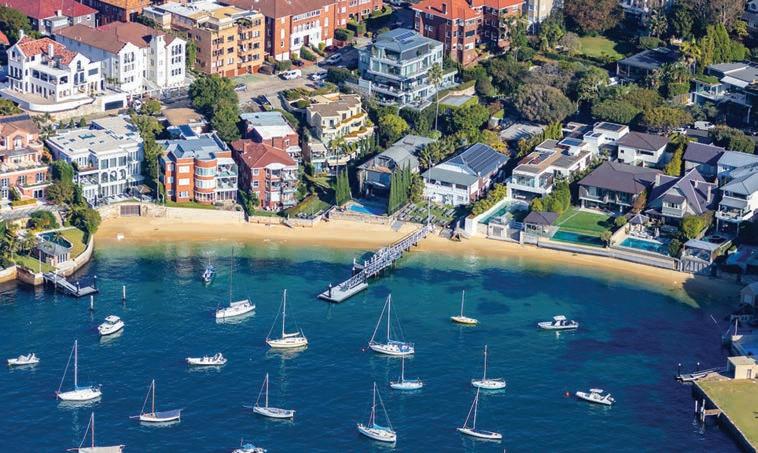
The motion caused division among the Liberal Party members present.
Councillor Sarah Swan, a comparatively youthful Liberal councillor, supported the proposal, telling those present that she is “deeply concerned about the range of young professionals” who cannot afford to live in the LGA. Even friends on salaries of $200,000 per year struggle to find accommodation in the area, she stated.
First Councillor Luise Elsing, meanwhile, said at the August meeting, “we want
The local council has asked strategic planning staff to produce a report investigating opportunities to alter the Woollhara Local Environment Plan 2014 to ensure there are rules in place to prevent a net loss in dwellings for new housing developments. The council also wants to lock in an obligatory Social Impact Statement where a reduction in dwelling numbers is proposed.
Waverley Council has already pursued similar planning controls. The eastern Sydney council is in the process of finalising the details.

Expressing frustration, Cr Grieve stated, “it shouldn’t be up to local governments to go back to the state planning department to tell them what to do.” Woollahra Council has recently come under fire for its resistance to new housing developments. The Sydney Morning Herald reported last month that Woollahra Council has only delivered 23 new affordable homes in 14 years. Sceptics have accused the council of weaponising heritage.
But the successful motion, intended to update planning controls and boost the LGA’s housing supply, suggests a possible shift in mood in the city’s exclusive eastern enclave as the gravity of Sydney’s housing situations takes hold.
It’s open slather for developers lining their pockets A beach in the Woollahra LGA. Photo: Woollahra Council/Facebook
 BY ROBBIE MASON
BY ROBBIE MASON
Aseemingly innocuous motion put forward by Mayor Darcy Bryne at an Inner West Council meeting last night led to a tense stand-off between councillors over a proposed local brewery festival in support of the yes campaign for the Voice to Parliament.
The motion called for Inner West Council to work alongside other local councils, non-profit organisations and local citizens to promote the yes campaign. It also suggested the council approach Yes 23 and the Uluru Dialogue about convening a “Walking Together for Yes” march in the city’s inner west.
But councillors expressed confusion and disgruntlement with the fifth section of the mayoral minute which suggested the local council write to the Inner West Brewers Association and craft breweries within the Inner West proposing they host a combined festival in support of the Voice to Parliament.
Greens Councillor Liz Atkins told City Hub that Inner West Council “shouldn’t be seen to be promoting the consumption of alcohol generally. Alcohol is the most widely abused drug in Australia.”
While recognising studies that show First Nations people are less likely to drink that non-First Nations people, Atkins described alcohol as a “sensitive issue”. “Festivals like Garma and Yabun in Victoria Park are dry.”
Waverley Council is continuing its education campaign about the upcoming historic Voice to Parliament referendum on Saturday 14 October. This vote will give all Australians the chance to come together and consider a change to our constitution that will honour and celebrate the rights, history, and ongoing relationship of Indigenous Australians with this land. On referendum day, voters will be asked to vote 'yes' or 'no' on a single question. The question on the ballot paper will be: “A Proposed Law: to alter the Constitution to recognise the First Peoples of Australia by establishing an Aboriginal and Torres Strait Islander Voice. Do you approve this proposed alteration?” Our Council supports the Uluru Statement from the Heart and the ‘Yes’ case for the referendum through a community education strategy. How you vote is up to you, so to find out more, visit voice.gov.au or refer to the Australian Electoral Commission’s official Yes/No referendum pamphlet being distributed to all households. Voting is compulsory for all adults, so please visit aec.gov.au/referendums/enrol/enrolto-vote.html to ensure your enrolment details are up to date.
Greens Councillor Marghanita Da Cruz asserted that “it is insensitive to the gravity of the Referendum” and that she has learned from past experience not to mix alcohol with dialogue with First Nations communities.

During the meeting, various councillors questioned why the mayoral minute chose to focus on the alcohol industry rather than other local businesses.
Entries for the Waverley Brightest & Best Business Awards close Monday 18 September and are open to all businesses operating in Waverley, whether your business is small or large, new or established. We’ll be announcing winners and runnersup on 13 November at our awards night at the Bondi Pavilion. Entries: waverley.awardsplatform.com.
Waverley Council has announced the shortlist for the 22nd annual Nib Award, recognising excellence in research and quality literature. The 2023 shortlist is: An Intimate History of Evolution: The Story of the Huxley Family by Alison Bashford (Allen Lane); Anam by André Dao (Hamish Hamilton); Emperors in Lilliput by Jim Davidson (The Miegunyah Press); The Age of Seeds by Fiona McMillian-Webster (Thames & Hudson Australia); Life So Full of Promise: further biographies of Australia’s lost generation by Ross McMullin (Scribe Publications) and Shirley Hazzard: A Writing Life by Brigitta Olubas (Virago). Vote for your favourite finalist to win the People’s Choice Prize and you could be a winner too! See waverley.nsw.gov.au/nib for more. Winners of the major categories will be announced on Thursday 9 November 2023.
Waverley Council is delighted to host the ARTEXPRESS Higher School Certificate Visual Art exhibition for the very first time. Enjoy a curated selection of works across all mediums from students from Brigidine College Randwick, Reddam House, Kambala, Sydney Grammar School, Moriah College, Sydney Girls
Mayor Darcy Bryne appeared frustrated before Council, accusing councillors of “disgraceful politicking”.
Independent Councillor John Stamolis said, “the point was glaringly out of context with a broad-based and inclusive motion supporting an Aboriginal Voice.” “Why can’t Council itself organise community events which invite Aboriginal speakers, performers and showcase Aboriginal artwork and culture?”
Cr Atkins told City Hub, “I thought it was insulting the way the Mayor implied that we don’t support the Voice referendum because we were asking for one section from the mayoral minute to be removed.”
Cr Atkins said that councillors have always unanimously endorsed motions supportive of the Voice to Parliament. An amended version of the motion with the sections relating to breweries omitted passed unanimously. Mayor Darcy Bryne appeared unremorseful telling the Council he would still contact local breweries and encourage them to collaborate and support the yes campaign.
HIgh School, Ascham School, St Clare’s College, Gosford High School, Figtree High School Wollongong and Trinity College Lismore at Bondi Pavilion Gallery until Sunday 24 September. Details: bondipavilion.com.au/whats_on/artexpress
Discover something new these spring school holidays with Waverley Council’s school holiday program including Children Are Stinky and Junkyard Beats at Bondi Pavilion. We have a great line-up of free and paid activities and events facilitated by a combination of Waverley Council specialist staff, artists, industry professionals and partner organisations to suit all ages at the Pavilion, Waverley Library, Margaret Whitlam Recreation Centre and Waverley/Woollahra Art School. Places fill up quickly, so to reserve your spot, visit the What’s On section of our website.
Waverley Council is proud to present the Waverley Volunteer Expo on Saturday 16 September from 11.30am to 2pm at the Bondi Pavilion courtyard. Meet our fantastic volunteers and the community organisations they help to support. There will be free talks, entertainment and more. Details: hwaverley.nsw.gov.au/recreation/events
Waverley Customer Service Centre: 55 Spring Street, Bondi Junction. Ph: 9083 8000
Stay in touch: waverley.nsw.gov.au/subscribe waverley.nsw.gov.au
Follow
It is insensitive to the gravity of the ReferendumInner West Mayor Darcy Bryne (left) walks alongside (now Prime Minister) Anthony Albanese in April 2022.
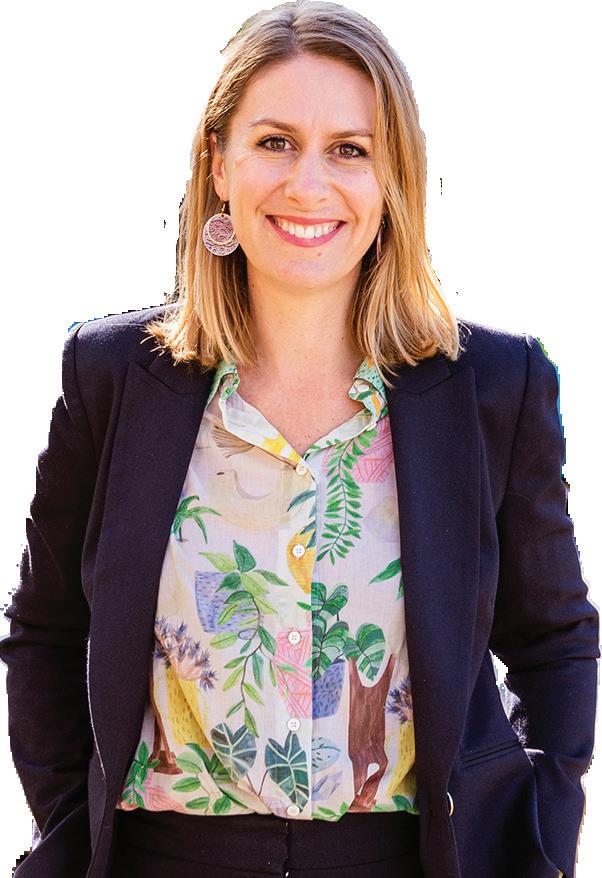 BY ROBBIE MASON
BY ROBBIE MASON
AC3 Pentecostal Church
congregation are vacating their premises in Darlinghurst, sparking relief among local residents who have accused the church group of threatening the neighbourhood’s vibrant identity. The church group is said to be leaving their home, named God in the City, due to a substantial rent increase.

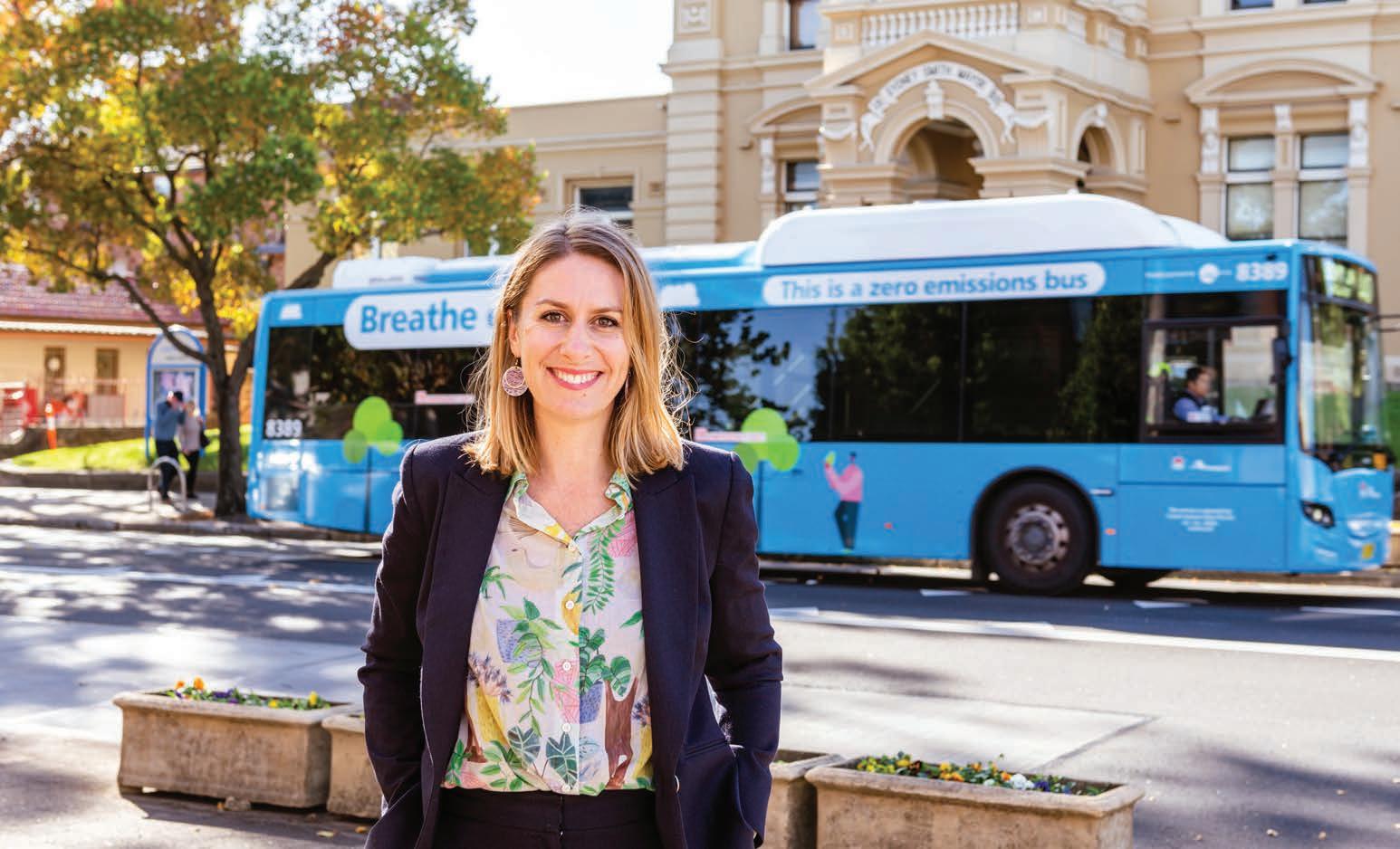
Locals have become accustomed to noise on a Sunday morning from the Hillsong offshoot. The church’s services regularly feature a full band with electric guitars, a keyboard and a drum kit.
One resident, who lives opposite the church, complained to City Hub of the noise.
have shut down or lost business due to noise,” he continued.


“It definitely feels like a double standard.”
sermons. Even in his own home, he is unable to escape the “loud” racket. It has taken a toll on his mental health.
vehicles and then when we asked nicely if they could move [their vehicles] there was always the ‘you gays are so entitled’, ‘go stick your pride’ etc, the same as when they chased after dog owners.”
“No resident in the area will miss them.”
The C3 Church movement began as a single contemporary church in Sydney’s northern beaches in the early 1980s. It has since expanded internationally. There are now over 500 C3 churches across the globe.
“They leave the door open during services,” he said. “I assume it’s part of their marketing strategy”.
“Them starting [their service] early on Sundays is frustrating since I work very late at night in the music industry. It feels frustrating that the church can be so loud in a residential area despite the fact that many of my beloved venues
A queer Darlinghurst resident, meanwhile, requesting anonymity, accused the church of queerphobia.
He told City Hub, “the C3 Church has been the most negative part about living in this beautiful LGBTQIA+ historic neighbourhood.”
The resident said he is forced to listen to the church’s frequent homophobic
“To give you an idea of the staff there, the groundskeeper liked to chase after dog owners and try to stop their dogs peeing in the plants around the church.”
“On three occasions he raised his fist to my face and on one of those actually threw a slow punch I was able to side step. All very Christian behaviour,” he continued.
“They never cared about residents, used to always block our cars in with their vehicles or access to our properties with their
Despite giving the outward appearance of a modern progressive rock-androll church, numerous media reports have exposed the denomination’s conservative politics, deeply-ingrained, financial ideology – the church promotes the idea that personal wealth is a Christian responsibility – and ties to fraud cases. The documentary #BLESSED shows the regressive stance of C3’s Toronto sect on queer rights. In 2019, a months-long investigation by A Current Affair illuminated the C3 Church’s sordid history of sex scandals, infidelity and child grooming.
The author of this article was unable to reach the God in the City congregation for comment due both their email and phone line being disconnected.
Agay Sydney man, who claims a NSW police officer kicked him in the head, damaging his hearing, during a home raid where he was a bystander, is seeking compensation from the state government.
NSW Police have claimed the incident never happened.
The alleged victim Tristan Hockings told City Hub that the incident left him with PTSD, shattered his faith in the state’s police force and forced him to resign from his nursing job at a major Sydney hospital. While he has always had hearing problems and long worn a hearing aid, he now needs a cochlear implant and an operation to have it inserted.

swept the premises as part of a drug raid targeting his date.
“It was absolutely terrifying,” he recounted.
to attract attention,” Mr Hockings alleges, “and then he kicked me in the head. I was seeing stars.”

Mr Hockings said that he has received little help during complaints processes, eroding his faith in police accountability.
Days after the search warrant operation in which he became entangled, Mr Hockings filed an official complaint with NSW Police.
“It took them 3 months for them to come to my home and interview about the assault. They didn’t really take it very seriously,” he said.
An internal police investigation found that no officers involved in the home raid operation had stepped out of line. “Nil sustained findings against any subject officer”, read the letter from police, dated 4 September 2019. His case was dismissed.
On 16 January, Tristan Hockings, then 36 years old, went on a Grindr date and slept in a Redfern home. On the morning of 17 January, 2019, “the sound of an angry mob” woke him as a NSW Police tactical response team
Once Mr Hockings realised the mob of men surrounding him were police, he calmed down, he told City Hub
When he was on the ground, restrained, a police officer approached him “making stupid animal growling sounds, just being an absolute clown.”
“He was looking side to side deliberately
Mr Hockings, who has no criminal record, expressed confusion over the motivation for the alleged assault, theorising that it may have been “a homophobic attack”. “Going up the stairs to the bedroom there was this Banksy artwork of two male English cops kissing.”
The matter will be settled in the District Court of NSW in November this year.
“I used to idealise the police; I wanted to be a cop myself,” Mr Hockings said. But he doesn’t trust police anymore. “It wasn’t just this lone officer, this bad egg,” he said, but the whole process which left him shaken.
A NSW Police spokesperson said they could not comment as the matter is before the court.
From the inner cities to the regions, we’ve all heard stories of people forced to sleep in cars or tents, families being priced out of their rental homes, and students and young people languishing in overcrowded sharehouses.
With every new horror story hitting the headlines, one thing is increasingly clear: the private housing system is broken. The cracks were years in the making, and choices by successive state and federal governments on both sides of the aisle to prioritise developer and investor profits, sell off public housing, and privatise public land have all contributed to the dire situation we face today.
Across the country, communities are feeling the effects of the worsening housing crisis - and coming together to build a powerful, grassroots movement for housing justice.
In early July, community activists and public housing tenants in Melbourne organised a defiant occupation of the Barak Beacon public housing estate as demolition crews rolled in.
The next month, hundreds took to the streets outside Labor’s national conference in Brisbane to demand the party finally take meaningful action to protect renters.
And in Sydney, a flurry of housing-related actions in the past month included a rally for a rent freeze outside the Sydney hearing of the Senate Inquiry into the rental crisis and a snap action, organised by Action for Public Housing, opposing NSW Labor’s shameful plans to demolish and privatise 70% of the Waterloo South public housing estate.
The movement for housing justice is gaining momentum - and we need to keep it up.
On Saturday September 9, we teamed up with GET A ROOM: Students for Affordable Housing to host a rally at Sydney Town Hall urging the NSW Labor Government to take serious action to address the housing crisis. Hundreds gathered to demand an immediate rent freeze, massive investment in new public housing, and higher taxes for developers and uber-wealthy corporate giants.
We know that sustained pressure and community action works. After months of negotiations and campaigning, the Federal Greens have just secured $1 billion in immediate funding for public and social housing, $2 billion for the social housing accelerator fund, and forced Labor to guarantee a $500 million annual spend from the next financial year.
It’s up to all of us to keep the pressure on. Investing in maintaining and expanding our public housing system is a key solution to the worsening housing crisis.
Sign our petition to defend and extend public housing: jennyleong.org/save_public_housing
 Jenny Leong MP Greens Member for Newtown
Jenny Leong MP Greens Member for Newtown


I used to idealise the police; I wanted to be a cop myself



The campaign for the referendum to recognise Aboriginal and Torres Strait Islander peoples in our constitution continues.
This referendum is about two things: recognition and listening. It’s a chance to recognise 65,000 years of First Nations history and culture, and to deliver practical outcomes to close the gap. With our referendum now announced for Saturday 14 October, we have work to do. There’s never been a more important time to get involved. The campaign needs all of us to win.
Make sure you’re enrolled to vote – go to www.aec.gov.au to check your enrolment, update your details, or get on the roll. For information on pre-polling or referendum day visit www.aec.gov.au or contact my office.
My office has fact sheets, posters, stickers and other helpful resources to share with your friends and family. If you’re interested in helping out please get in touch with my office.
As your local representative, I can assist with enquiries or problems with Federal Government departments and services like Centrelink, immigration, Child Support payments, and Medicare. Please get in touch if you need anything.
BY ROBBIE MASONThe relationship between the Australian Services Union (ASU) and upper management at Sydney Water has further deteriorated with claims that the former Coalition government wanted to privatise the publicly-owned corporation resurfacing and attacks becoming personal. The union is now calling on Water Minister Rose Jackson to sack managing director Roch Cheroux.
According to correspondence obtained by the Sydney Morning Herald, ASU NSW and ACT branch secretary Angus McFarland wrote to the Water Minister last week, claiming that Cheroux was a political appointment. In a scathing two page letter, McFarland asserts that Cheroux was part of an underhand Coalition scheme to privatise Sydney Water.
In the build-up the last state election, media reports revealed that the Coalition government had spent $400,000 paying consultancy firms to investigate the benefits and drawbacks of privatising the utility. In response, Labor accused the Coalition of wanting to privatise Sydney Water.
In the letter to Minister Jackson, McFarland also alleges that Cheroux has assumed “hyper-aggressive, Americanstyle union-busting tactics”, including adding certain unions to a list of banned websites alongside pornography and gambling sites.
McFarland writes that the union have “never encountered an executive team so openly hostile to workers and so
unapologetically destructive to the social purpose of Sydney Water” as the current management team.
Water Minister Rose Jackson said she is meeting with representatives from the ASU “in the next week or two to discuss their concerns directly” including the wage offer currently on the table, which Sydney Water staff will vote on next week. The offer is for an 11 percent wage increase over three years.


The news follows the breakdown of wage negotiations in July this year amid worsening working conditions and accusations that the state-owned corporation has implemented outdated, secretive WorkChoices style contracts. At the end of July, Sydney Water workers lodged a dispute with the Fair Work Commission.
According to the ASU, morale among workers at Sydney Water is at an alltime low.
Minister Jackson told City Hub, “employees have expressed frustration with the progress of their Enterprise Agreement negotiations and it is disappointing to hear that workers don’t feel heard or appreciated.”
“I expect Sydney Water to listen and act on the concerns raised by employees.”

It is disappointing to hear that workers don’t feel heard or appreciatedWater Minister Rose Jackson. Photo: Rose Jackson/Facebook
In 725, the French born Bishop (later Saint), Korbinian arrived in the district of Freising in Bavaria (Germany). He and a dozen companions founded a Benedictine monastery on Nähberg Hill; it became known as Weihenstephan Abbey and gave its name to the surrounding district.
Evidence that the monastery might be involved in the brewing of beer comes from a document from 768 indicating that hops were being grown in the immediate vicinity. In fact, it would have been unusual if the monks were not making beer.
During the middle ages, beer was the most consumed beverage in Europe, often being safer to drink than plain water. Many people made their own brews at home and it was generally pretty rough. However, from as early as the 400s, monasteries in France were making beer and the practice quickly spread to other European countries.

The monastic approach to brewing was methodical, rigorous, and very technical; much of the knowledge and process that is used today was developed within those ancient cloistered walls.
Alas, for Weihenstephan Abbey, any functioning brewery they had at this time was destroyed along with the rest of the monastery when Hungarians attacked in 955. Proving their tenacity, the Benedictines rebuilt on the same spot.
By 1040, Weihenstephan was back in brewing business - literally. Abbott Arnold was granted an official licence by the City of Freising. But, while they now had a viable revenue stream, the monks’ problems were far from over.
Between 1085 and 1463, Weihenstephan was burnt to cinders and rebuilt from scratch four times; the abbey population was decimated by three different plagues; the Hungarians attacked again, then the Swedes and
Bavarian State Brewery Weihenstephan can lay legitimate claim to being the oldest brewery in the world. Historical documents confirm that in 1040AD, Weihenstephan was officially given a licence to produce and sell beer by the local authorities. But the brewing history of this ancient estate on a hill in Germany dates back even further.
name change to Bavarian State Brewery Weihenstephan. With its incorporation of the Technical University of Munich in 1930, the brewery became and still is one of the most advanced and prestigious breweries in the world. So, what about the beer? How good is it? Well, at this year’s Australian International Beer Awards (AIBA), the Bavarian State Brewery Weihenstephan medalled on every single one of the eight different beers they entered. Their Kristallweissbier won gold for the third year in a row. Kristallweissbier is one of Weihenstephan’s showcase beers and has received many awards. It is, as its name suggests, a crystal clear wheat beer, with a crisp effervescence and top notes of banana.
then France; they endured famine and an almighty earthquake.
Yet, somehow, they not only survived but flourished.
The beer-making process continued to develop throughout Europe with results varying from delicious to dangerous.
In 1516, Duke Wilhelm IV of Bavaria announced a decree that only water, hops and barley could be used in the making of beer. This was known as the Bavarian Purity Law and it gave beer from the region a distinguishing quality that still is present today.
Weihenstephan Abbey continued to produce beer, improving the process and the quality of their ingredients until March 24, 1803. On that day, the monastery fell victim to the
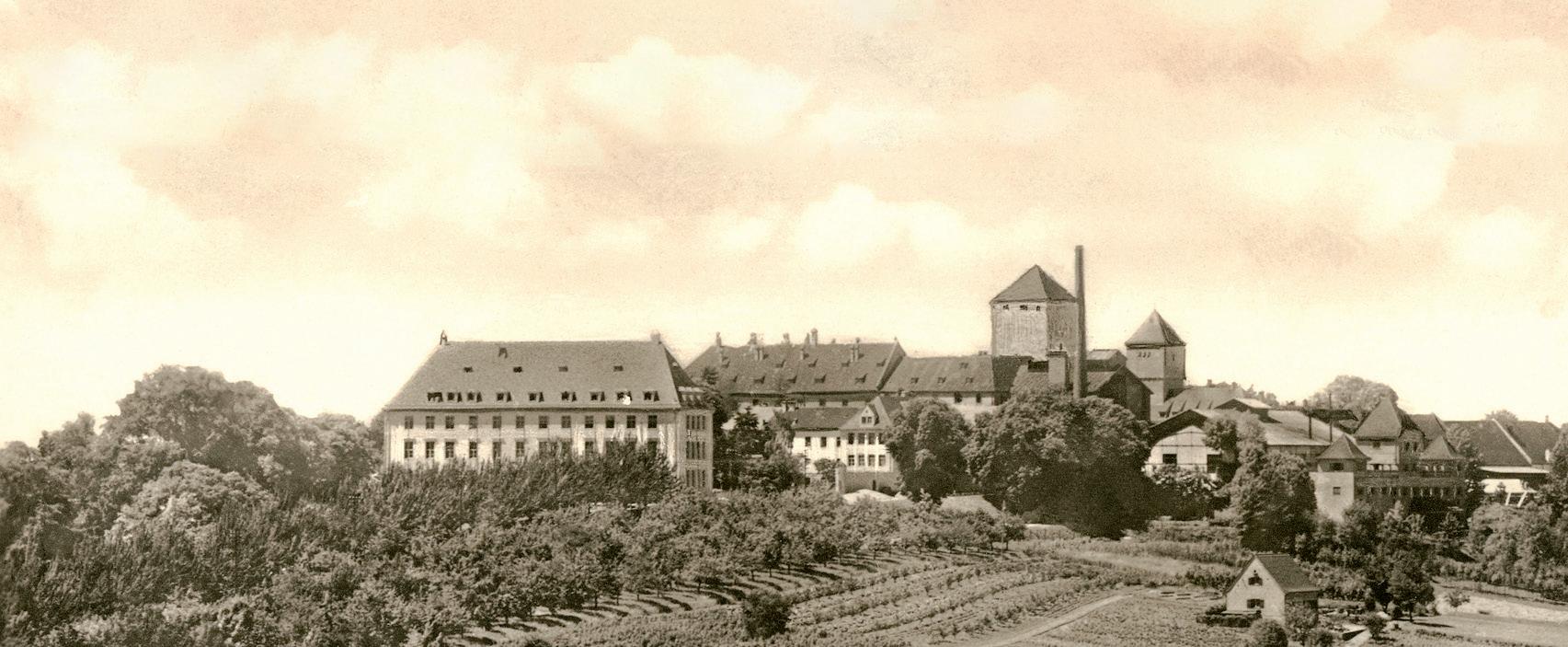
restructuring and secularisation that was happening across Germany. The State took ownership of the land, the buildings, intellectual property and, of course, the brewery, all of which were absorbed into the holdings of the royal house of Schleissheim.
It wasn’t the end of the beer, though. Not by a long shot.
Weihenstephan powered on as one of the most innovative breweries in the land, and in 1852, the esteemed Central Agricultural School Schleissheim was moved to the erstwhile abbey. Some 40 years later, the school was upgraded to an academy and then in 1919 it became the University of Agriculture and Brewing.
In 1921, the institution had a final
Silver medals went to Original Helles and Weizenbock Vitus (both bottled), while bronze was awarded to Kristallweissbier (this time in a keg), Original Helles, Hefeweissbier (both in a keg), and Kellerbier 1516, Hefeweissbier, and Hefeweissbier Dunkel (all bottled). Weihenstephan’s range also includes the Korbinian, named after the founder of the monastery. It’s a rich, dark beer with sweet, roasted malt flavour. They have a sharp, bitter Pilsner; the celebrational Festbier; and a nonalcoholic wheat beer made using a unique method that delivers a low-carb beer that is full on flavour.
While Bavarian State Brewery Weihenstephan is very technologically advanced, many of its processes are carbon neutral and there is a strong ethos within the organisation to be sustainable, green, and in harmony with nature.
When you see a Weihenstephan beer being poured, you are seeing more than a thousand years of diligence, experimentation, resilience, dedication, knowledge and passion filling that glass. And it tastes magnificent.

The electrification of homes and businesses in the City of Sydney is under way with the City of Sydney Council carrying a motion exploring the enforcement of renewable energy alternatives for new developments at a meeting on Monday 21 August.
The motion, put forward by Councillor Waskam Esmelda Davis and seconded by Deputy Mayor Sylvie Ellsmore, called on Lord Mayor Clover Moore to write to NSW Premier Chris Minns, urging him to introduce rebates or other incentives to transition homes and businesses from gas to renewable energy.
All Councillors – bar the two Liberal councillors, Councillor Gannon and Councillor Jarrett – voted in support of the motion.
From October 1 this year, the City’s Net Zero Performance controls will come into effect, requiring that new office, hotel and retail developments “reduce energy use through efficiency and renewable energy” or achieve net zero energy “prior to commencing use”, as noted by the council minutes.
Although this will contribute to the targets set by the City of Sydney and the NSW government to reach net zero emissions by 2035 and 2050 respectively, these standards will not apply to new residential developments.
This is because the current and upcoming State Environmental Planning Policy (SEPP) prevents councils from setting higher environmental requirements than that of state planning policy.
The City of Sydney Council has now indicated that this is nowhere near good enough.
The Lord Mayor told City Hub, “we need to do everything we can urgently to lower our emissions.”
“I have advocated for and would welcome a state-wide mandate on banning gas connections by the NSW Government, as has been done in Victoria,” she said.

“Until that happens, we’re looking at other ways we can electrify residential homes and reduce new gas connections within the City of Sydney.”
Deputy Mayor Ellsmore, a Greens councillor, is similarly dissatisfied with the current state policy.
“The NSW State Labor Government has ruled out a state-wide gas ban,” she told City Hub,
but that doesn’t stop local councils stepping up and showing leadership.”
The City of Sydney now join other councils including Waverley, Parramatta, Randwick and Canterbury-Bankstown which have already implemented varying gas bans for new residential developments.
The motion requested that the City of Sydney CEO investigate the potential means and challenges of requiring new developments outside of the current Net Zero planning controls to be all electric.
“I am hopeful that the investigation is fruitful and comes back with constructive
ways we can continue our transition away from fossil fuels,” the Lord Mayor said. Deputy Mayor Ellsmore was quick to point out the many benefits this change would have on City of Sydney residents.
“As well as the environmental impact, gas is highly toxic for human health, including when used inside for cooking,” she said. “The gas industry has been exposed for decades for green-washing, for marketing gas as a healthy option when in fact it has been linked to increases in cancer and childhood asthma.”
Deputy Mayor Ellsmore also highlighted the rising cost of gas.
“Estimates are that gas now costs households a whopping extra $900 per year – by 2030 this will be more than $2000,” she said.
Amidst the current cost of living crisis and climate emergency, the step towards electrifying Sydney appears an important one.
Health professionals and climate change organisations have welcomed the announcement.
In fact, 12 percent of childhood asthma in Australia has been associated with gas cooktops, according to a 2018 study in the Medical Journal of Australia Additionally, gas stoves and ovens have been linked to carcinogenic chemicals like benzene by Stanford University researchers.
Dr Ben Ewald, an epidemiology expert and member of health advocacy organisation Doctors for the Environment, said, “the flames of a gas stove or heater release toxic chemicals that cause asthma in susceptible people. Everyone with a gas stove should open a window or turn on an extractor fan every time they light it. Not connecting to gas in the first place is a better option, as all uses of indoor gas now have a better electric alternative.”
The motion was a response to a grassroots ‘Electrify Your Council’ campaign by climate organisation 350 Australia.
Lucy Manne, CEO at 350 Australia said, “gas is a potent, fossil fuel that is accelerating the intersecting human and ecological crises caused by a heating planet. “Only developers and gas corporations benefit from keeping our homes and businesses connected to gas.”
Bronwyn McDonald, NSW Campaigner for Healthy Futures, an alliance of health organisations said, “a child living with a gas stove faces a similar asthma risk to a child exposed to secondhand cigarette smoke.”
“To protect vulnerable people like children, the elderly and people with medical conditions, health professionals call on the state government to urgently phase out gas from buildings like homes, schools and hospitals.”
The gas industry has been exposed for decades for green-washing
Public housing tenants and supporters met with Greens MP Kobi Shetty on Wednesday morning to hand over a petition with hundreds of signatures which opposes the planned demolition of public housing units at 82 Wentworth Park Road, Glebe. Activists invited Housing Minister Rose Jackson to the staged handover but she declined to attend.
Carolyn Ienna, a recently-evicted 30year Wiradjuri resident at 82 Wentworth Park Road, presented the Member for Balmain, Kobi Shetty, with the thick wad of documents.
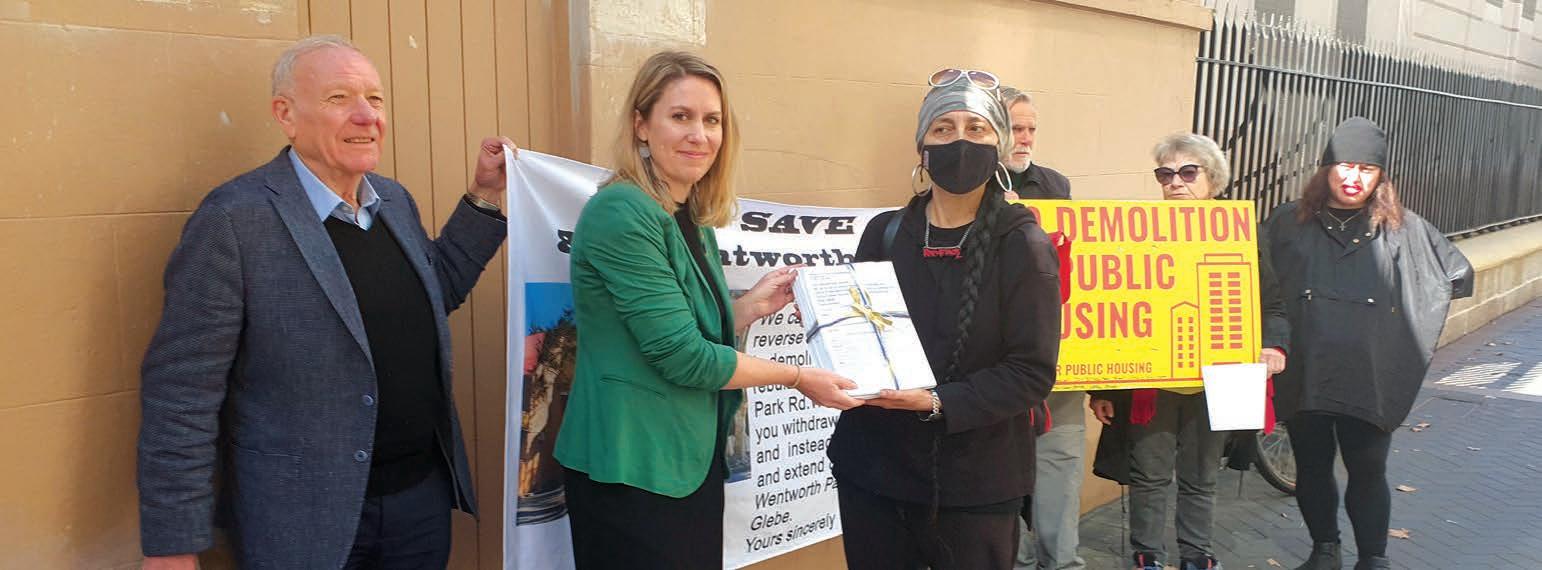
Bar one unit, almost all of the 17 homes at the site are currently sitting empty during a citywide housing crisis.
Denis Doherty from community group Hands Off Glebe said the local community want the building filled immediately.
“The sooner we get it back into operation the better,” he stated.
Shetty said, “the government needs to renovate, not detonate. This plan will remove public housing stock for years to come.”
Ienna wants the units at 82 Wentworth Park refurbished and “used for their original purpose – to house people on low incomes”.
Hands Off Glebe conducted a letterbox campaign to assess the perspective of the local community on the planned demolition and redevelopment of the Glebe public housing site. Volunteers dropped off unsolicited letters to 5000 mailboxes and received over 430 supportive responses, representing a substantial hit rate of almost 10 percent.
Denis Doherty from Hands Off Glebe told City Hub that the community response to the campaign to save 82 Wentworth Park
Road has been heart-warming and well above average.
“Whenever we’ve run stalls in the local high street, we’ve been amazed by the number of people who are more than happy to sign [the petition],” Doherty said.
“I’ve run stalls around the AUKUS issue and haven’t had the same response.”
Community groups including Hands Off Glebe, the Glebe Society and Action for Public Housing, have argued that the planned demolition of the Glebe site does not align with contemporary, goldstandard architectural practices.
Local community groups have demanded a more sensible approach to housing that acknowledges the mental and physical toll of forced relocation on public housing tenants and the substantial environmental cost of demolition and reconstruction.
Dr Hannah Middleton from Hands Off Glebe said, “whoever is advising Minister Jackson has clearly not caught up with the latest thinking on housing construction which respects the human, environmental and economic benefits of renovation instead of demolition.”
“It is time her department moved into the 21st century,” she added.
The units at 82 Wentworth Park Road were built in the 1980s.
will cost in the vicinity of $1 million. But Hector Abraham Architects estimates that the firm’s own plan, which will deliver 52 bedrooms, only one less than the current DA, will save $7 million. The Abraham Architects plan also includes threebedroom units which, under the current proposal, would disappear entirely from the site.
Ian Stephenson from the Glebe Society pointed out that “professionallydeveloped alternative plans to refurbish ‘82’ and create more homes through infill construction have been presented to the [Housing] Minister [Rose Jackson].”
“However, she and her staff appear unwilling to budge,” he continued.
Emily Valentine, Secretary for Hands Off Glebe, said, “the Royal Institute of British Architects has created a new prize to encourage architects to pour their creativity into refurbishing existing buildings, rather than demolishing them.”
“If developers replace an existing building with a new one, vast amounts of carbon dioxide are created to make the bricks, cement and steel for the replacement. If instead they can renovate the existing building, emissions are greatly reduced,” she said.
Cement production, for instance, contributes to 8 percent of global greenhouse gas emissions which is roughly the same amount as the world’s car fleet contributes. This makes cement production the single biggest industrial cause of carbon pollution.
In July this year, Action for Public Housing hosted a community forum, No more demolitions: Alternatives to public housing redevelopment, where a range of speakers presented alternative approaches to Sydney’s housing crisis. Keeping communities intact and upgrading public housing without demolition and displacement was a common theme at the free public forum. There, renowned conservation architect Hector Abrahams from Hector Abrahams Architect outlined an alternative scheme for 82 Wentworth Park Road that does not involve demolition but, rather, additional density at the rear of the complex and refurbishment. Embedded in the scheme is a lift for accessibility and a large central garden.
Those backing the plan have emphasised that it makes more sense financially. The current DA for the site proposes 53 bedrooms at a cost of roughly $22 million, meaning each new bedroom
In a letter to Kobi Shetty, addressing the Glebe Society proposal, dated 24 July, Housing Minister Rose Jackson told the Greens politician that Land and Housing Corporation staff had “fully reviewed” the alternative proposal and decided to plough ahead, business as usual, with the current DA, rather than the proposal of community activists.
Doherty from Hand Off Glebe said, “they should spend the millions planned for demolition and rebuilding to instead expand public housing on the old Glebe Fish Market site.”
The state government has pencilled in 1200 high-rise luxury apartments for the Blackwattle Bay site with no commitment to any public housing construction. According to The Guardian’s recentlyreleased gentrification index, which is based on data from the Australian Urban Observatory, both Glebe and Forest Lodge fall into the most severe category for gentrification – “advanced exclusive”. This ranking means that the neighbouring suburbs are “largely exclusive to high income households.
The government needs to renovate, not detonate
synagogue and “there is no underlying or growing demand for synagogues”. He then went on to write: “this correct zoning [the proposed rezoning] means that I can continue to fund the Yeshiva Complex with confidence. Otherwise, if the wrong zoning stays, it would encourage me to stop giving money so it stops and then get the correct zoning.”
Yeshiva College, an ultra-orthodox Jewish school at the site, shut in September last year after reports emerged that the school was using government funding to pay unaccredited teachers and placing students’ safety at risk.
Waverley Council is embroiled in a heritage standoff with billionaire real-estate tycoon Harry Triguboff.
Waverley Council wants a 1950s synagogue in Bondi, owned by Triguboff, heritage listed but Triguboff wants to turn the site into medium-density residential housing.
The site in question houses the Yeshiva College, also known as the Harry O. Triguboff Centre. This complex includes the synagogue, a learning centre and a library, as well as a food bank charity called Our Big Kitchen which distributes roughly 250,000 meals annually to those in need.
Waverley Mayor Paula Masselos said it was vital to preserve community spaces, as well as the local area’s distinctive architecture.
“This is the cherished home of a local religious community and we need to prioritise that,” Mayor Masselos stated.
Last year, the local council blocked a rezoning proposal by Kanimbla, the development arm of Triguboff’s property development business Meriton. But later that year, in November, the Department of Planning and Environment overturned this decision following a review process, ruling that the rezoning should proceed.
Following anxiety and dismay among sections of the Jewish community, Waverley Council placed an interim heritage order on the site while experts assessed the cultural, architectural and historical significance of the site.
A detailed heritage assessment, undertaken by Hector Abraham Architects in May 2023, determined the site is worthy of long-term heritage protection.
Reflecting the Bauhaus interpretation of internationally-acclaimed architect Harry Seidler, the synagogue’s design was ground-breaking for its time. The building has eye-catching sculptural concrete architecture and semi-circular window archways reminiscent of barrels or shells.
The Yashiva Centre also holds religious and educational importance as the first Talmudical school in Australia with a synagogue attached.
Waverley Council is now seeking community feedback for a heritage listing proposal which is on public exhibition until 14 September.
Harry Haddow, President of the NSW chapter of the Australian Institute of Architects, emphasised Harry Seidler’s significance as an architect.

Haddow said, “he heralded modernism in Australia and delivered some of the most remarkable projects in Sydney –Australia Square and the Rose Seidler House to name just two. This building is his only religious building – what a travesty if we were to allow it to be demolished.”
Haddow asserted that turning the synagogue into medium-density housing would be “akin to converting St. Mary’s cathedral into a drive through McDonald’s.”
Liberal Councillor Leon Goltsman, who represents the Bondi ward, told City Hub, “while the demand for housing is an urgent and valid concern, decisions
like these must be approached with careful consideration of all stakeholders’ interests and a genuine understanding of the site’s unique value.”
“Striving for progress must harmonise with honouring our shared history,” Cr Goltsman continued. “The question isn’t merely about bricks and mortar but the soul of our community.”
The daughter of the synagogue’s architect, Harry Seidler, has thrown her support behind the preservation of the building. She previously told the Sydney Morning Herald that the site is “worth preserving”. She suggested to that masthead that it could be used for new purposes.
Meriton, which appears to have a penchant for rezoning proposals, has faced fierce opposition in the city’s east in recent times. In July this year, Meriton’s attempt to rezone Little Bay Cove and turn the seaside site into high-rise tower blocks was rejected for a third time following ongoing community dissent, council opposition and scepticism from state government urban planners.
Triguboff has long used the media to air his displeasure over local councils and resident action groups who rally against housing redevelopments.
In June, Triguboff penned an opinion piece for The Australian in which he lambasted the “hysterical reaction” to rent rises and large-scale redevelopment projections and complained that homeowners suffered during the COVID-19 pandemic. He also called for local councils and the Department of Planning and Environment to approve, rather than delay, redevelopments amid the city’s housing crisis.
“This space is suitable for any public recreation,” she said. “It doesn’t have to be a synagogue. It could be a community hall.”
While Meriton wants to build homes where the historic synagogue sits, the fine details of Harry Triguboff’s aspirations for the site remain shrouded in mystery.
In a letter, dated 11 September 2022, to the Sydney Eastern City Planning Panel, who reviewed Meriton’s rezoning proposal, Triguboff appears to exploit his own funding for the Yeshiva Centre as a bargaining chip.
In that communication, he wrote that “attendance rates are low” at the
“All kinds of figures are quoted by various characters who know nothing, but unfortunately are quoted by the papers,” he wrote for The Australian Mayor Masselos asserted that Waverley Council is “not using heritage to limit housing development at all”.
“There is a very bona fide reason for protecting this important site and it is there for our community for the future,” Mayor Masselos stated, adding that Waverley Council must “acknowledge the diversity of our community”.
Data from the Australian Bureau of Statistics shows that Waverley Council has the third-highest dwelling density of all 130 NSW council areas at 3,487 dwellings per square kilometre, although this figure does not account for population growth. Meriton did not reply to questions in time for publication.
The question isn’t merely about bricks and mortar but the soul of our communityHistoric photo of the Flood Street synagogue, 1964. Photo: Max Dupain, copyright Penelope Seidler
Paddington locals have gathered in support of The Village Inn to protest a recent development application (DA) which seeks to transform the property into a retail outlet.
The heritage listed Rose and Crown Hotel Paddington, known as ‘The Village Inn’, is one of the community’s oldest pubs and has been in operation since 1890.
However, a DA from fashion label Alemais plans to change the pub into a clothing shop and office space.
On Saturday August 12, community action group Save The Village Inn held a sit-in protest to object to the DA proposal. They have also started an online petition.
Action group spokesperson William Marshall, a Glenmore Road, Paddington, resident, spoke to City Hub regarding the group’s quick response to the proposed changes.
Marshall said, “the Village Inn pub serves as a meeting place, a tourist destination, and a family-friendly venue.”
Referring to the pub as the “engine” of the “car” that is Paddington, Marshal noted the building’s resilience throughout its 130 years of operation.
“Despite demographic shifts, it has adapted to changes in the local and wider Sydney community,” said Marshall.
“The hotel attracts a diverse clientele, including university students, locals, visitors, families, people attending sporting venues, single individuals, and couples of all backgrounds.”
Marshall explained that the change would heavily impact the social lives of Paddington locals, referring to the pub as their “living room” meeting space.
an abundance of vacant shops and offices.”
“The proposal exacerbates the current oversupply of retail property and office space,” explained Marshall.
“The occupancy rate in Paddington is approximately 65 to 70 percent, and areas like Oxford Street, William Street, and Darlinghurst already have
Since the proposal was made public, Councillor Harriet Price has spoken out against the proposed change in support of the established pub. Writing on social media, Cr Price questioned, “does the [intersection of Paddington] really need another dress shop?”
Price told City Hub that pubs are “a part of the intrinsic character of Paddington…enhancing the suburb’s character and rich history.”
“Pubs are recognised as a valuable ‘third space’, providing meeting
spaces and opportunities for social connections, reciprocity and companionship. A sense of community and belonging disappears when a pub closes,” continued Cr Price.
The DA notes Alemais’ plan to make “alterations and additions” to the building’s exterior, aiming to “change of use from Hotel/Pub to retail on the ground floor” and offices on the first and second floor.
While the DA is yet to be approved, it is expected the Woollahra/Paddington community will continue to object to the plans in favour of the beloved pub.

www.catprotection.org.au
/catprotectionsocietynsw
Rehoming Organisation Number R251000224



Name: Karen
Age: 1 year (est)
Colour: Female White DSH
Charming Karen isn’t really too demanding, all she asks for is some TLC, your company and a cosy bed for catnapping. This chatty kitty likes to have her say and might request extra treats but as the manager of her mealtimes you’ll be able resolve any dinnertime discrepancies quickly with an extra helping of cuddles. An affectionate and friendly feline, Karen just loves being the centre of attention and wants to be the only cat in your life, but she has loads of love to share and she’ll make sure you’re never short on purrs. Karen enjoys nothing more than curling up in a comfy, cosy bed and will happily daydream the day away occasionally stretching out for a chin scratch or two. She is looking for an indoor-only forever home to protect her pretty pale features and sensitive skin. You’ll feel very privileged to have this lovable lady snuggled up next to you.
Call the Cat Protection Society of NSW on 02 9557 4818 or visit www.catprotection.org.au
Rehoming Organisation Number: R251000224

Since 1958 Cat Protection has been helping cats and the people who love them. We need your help to continue our life-saving work.
The proposal exacerbates the current oversupply of retail property and office spaceThe Village Inn, Paddington. Photo: Sydney City Guide
The NSW Labor government has committed to the demolition and redevelopment of the Waterloo public housing estate, sparking frustration among tenants and advocacy groups.

Of the 3000 new apartments planned for the Waterloo South portion of the estate, half will be social and affordable housing, the NSW government announced yesterday. The announcement represents an improvement on the former government’s mandate of 34 percent social and affordable housing. The new plan will add 53 social homes, as well as 373 affordable homes, to the present number.
But the news has received mixed reactions. Impact tenants and community groups have condemned the announcement as inadequate and a clear-cut broken promise from NSW Labor.
Dr Alistair Sisson, a housing expert from the Macquarie School of Social Sciences and member of Action for Public Housing, condemned the announcement in light of the 55,000 households on the social housing waiting list and the “negligible growth” in public housing stock.
Geoff Turnbull from REDWatch, an inner-city community action group, said the proposed increase in the number of social and affordable homes is “very modest”.
“It isn’t going to make a dent in terms of the waiting list”, Turnbull said.
Shelter NSW chief executive John Engeler
said the revised plans represent a significant improvement on the original proposal. But he wants to see the state government and urban planners present a more radical vision for the central and northern portions of the public housing estate.
At a press conference hosted by Action for Public Housing on 21 August, Karyn Brown, a South Waterloo resident and Action for Public Housing member, said she was against the demolition of homes in a housing crisis.
Action for Public Housing have long held a policy of “no demolitions” to public housing and filling vacant homes.
In Karyn’s words, bulldozing public housing is “like trying to stop a flood with a firehose.”
“It will give Sydney yet another vacant block of land,” she continued.
Ruby, a relatively new resident at the Waterloo Estate, said they do not feel at all secure in their current housing. The uncertainty of the site’s future has fostered an atmosphere where residents are “barely able to talk to each other” and “do not feel comfortable voicing their opinions to a largely white middle class government about their business plans for the area”.
Despite the atmosphere of apprehensiveness and the presence of crime, Ruby expressed affection for the Waterloo Estate, labelling the tower blocks “a safe haven” and the people “vibrant”.
Ruby sympathised with neighbours who have lived in Waterloo for decades.
“There’s no respect for the history of a neighbourhood and its culture,” they said. “There are famous locals and respected elders who’ve been here almost all their lives.”
Waterloo Estate tenants are the not only locals who will miss the effervescent inner-city public housing community.
Andrew Chuter, President of Friends of Erskineville, told City Hub, “one thing that makes the inner city so great is the diversity of cultures, backgrounds and viewpoints. We want people of all means to be able to live here but the demolition and privatisation of public housing is making it a place for only the wealthy.”
NSW Government without a single public housing dwelling,” he continued. Echoing the stance of Dr Sisson, Waterloo resident Karyn Brown said, “the destruction of perfectly good homes is environmentally unsound, they should be retained and refurbished to have the longest life possible. We have done away with disposable shopping bags, it is time we stopped seeing people’s homes as disposable.”
Norrie, another Waterloo Estate resident, said her living situation has been up in the air ever since she moved into the area. But she acknowledged that Labor’s announcement yesterday possesses more merit than the plan of the former Liberal government.
She said she is open to relocation, provided the eventual redevelopment houses a larger portion of vulnerable citizens.
Ruby said, “there should be more public housing” but gave City Hub one important caveat: “fix and maintain what you have. It seems a huge project for not much gain.”
Dr Alistair Sisson made a similar point: “The homes in Waterloo South are decent quality; there has never been a condition assessment to prove that they are inadequate or beyond repair.”
“A better approach would be to refurbish the homes in Waterloo South, acquire new homes and build new public housing on sites like North Eveleigh, which are being redeveloped by the
“It’s an inconvenience moving but I can cop it if it means a lot more people are going to get housed. I appreciate having an affordable roof over my head. I wouldn’t begrudge anyone else having that right.”
NSW Labor came into power this year on the back of a “Hands Off Waterloo” pre-election campaign. In the build up to the state selection, local Labor MP Ron Hoenig sent letters to Waterloo public housing tenants telling them they could “stop the sell-off of the Waterloo Public Housing Estate” and “protect” their homes by voting Labor.
It will give Sydney yet another vacant block of landWaterloo South resident Karyn Brown (left) with members of Actions for Public Housing at a press conference, 21 August 2023. Photo: Robbie Mason
Labor’s backing of public housing did not emerge from thin air. At a NSW Labor conference in October 2022, Labor made a concrete pledge to implement a moratorium on the sale, outsourcing and leasing any public housing assets or services.
Despite inconsistent messaging and slow communication with inner-city public housing tenants plaguing the state government in recent months, Housing Minister Rose Jackson has stuck to the rhetoric that Labor will defend public housing. Speaking at a REDwatch meeting in June this year, Housing Minister Rose Jackson indicated that she considers the conference resolution to be the state government’s policy.
But critics have pointed out that Labor’s housing policy runs contrary to the pledge of no privatisation. The state government is selling public housing “by stealth” Zac Gillies-Palmer has written for Jacobin
In June this year, tenants told The Guardian they felt misled. Some had dug into their own pockets to fund home repairs, erroneously believing their homes were safe following Labor’s promises.
Friends of Erskineville President Andrew Chuter said the announcement of the

small boost to social and affordable housing is “disappointing given the statements and commitments made before the state election”.
Even social housing can be managed by a third-party operators, Action for Public Housing have stated, as social housing includes community housing, which not-for-profit organisations tend to manage. Community housing providers can charge higher rent and more easily evict tenants.
This renders the provision of an additional 53 social homes in Waterloo South, as per the state government’s announcement yesterday, a relatively
She doesn’t want a repeat.
In a media statement, Jenny Leong, the Member for Newtown and Greens NSW Spokesperson for Housing and Homelessness said that NSW Labor have failed to end the Liberal Party’s “privatisation agenda”.
“Instead they are continuing this shameful legacy of evicting public housing tenants from their homes, for insulting increases to social housing stock that barely touch the sides of the housing crisis.”
Community groups are wary of Labor’s focus on affordable housing which is often inaccessible for low-income earners.
pulled from the [social housing] waiting list into affordable housing are relatively small” due to the preference among affordable housing providers for tenants with employment and the focus on retaining “key workers” within the inner city.
The independent non-profit organisation Shelter NSW, however, views the affordable housing boost more favourably.
CEO John Engeler stated, “we’ve long called for more affordable rental housing – in addition to social housing, not instead of it. We are pleased to see a substantial amount of affordable housing being locked in for this site. This type of housing and tenancy offers hope for key workers, particularly those currently supporting the local community.”
insipid pledge to those invested in preserving public housing.
Norrie harbours reservations over the management of her future Waterloo domicile. She told City Hub that she had lived in co-operative affordable housing prior to her move to Waterloo in 2018. There, the rules were stricter. She wasn’t allowed to have any pets, meaning temporary separation from her cat, and she wasn’t allowed to smoke indoors.
Action for Public Housing have pointed out that a two-bedroom ‘affordable’ apartment in Waterloo, if built today, could be leased for $776 per week. The group have drawn the data from the latest rental bond lodgements. Affordable housing will make up 20 percent of the new homes built in Waterloo, while social housing will make up 30 percent.
Geoff Turnbull from REDWatch told City Hub that “the chances of people being
It is not clear whether the affordable housing earmarked for Waterloo South will remain affordable housing in perpetuity. According to current planning laws, affordable housing only needs remain as such for 15 years.
When questioned in NSW parliament by the Member for Newtown, Jenny Leong, NSW Premier Chris Minss refused to make a commitment and mandate that affordable housing at Waterloo South remain affordable in the long-term.



85 percent of the participants in the Antipoverty Centre and GetUp study said they had experienced issues with job providers mistakenly cutting off income support payments.

The report highlights not only cases of mental harm but unreported physical harm and negligence.
One anonymous survey contributor said, “I was told I would be doing ‘retail’ training at Salvation Army. I was actually told to move furniture around. I slipped a disc in my back and have had serious back issues ever since. The job agency I was tied to swept it under the table, it was never logged as an accident with anyone.”
Anew report from GetUp and the Antipoverty Centre has labelled Australia’s social security system a “poverty machine” and exposed the insidious impacts of ‘mutual’ obligations on the mental health and financial status of welfare recipients.
The nation’s social security system is rife with bullying, harassment, discrimination and administrative payment errors, the Punishment for Profit report details.
Lead author Jay Coonan from the Antipoverty Centre, a non-partisan advocacy organisation run by people with direct contemporary experience of poverty and unemployment, said, “this is a system that punishes us for being poor. ‘Mutual’ obligations exist to deter people from accessing welfare, not to help us find a suitable job.”
93 percent of the study’s 600 participants said ‘mutual’ obligations directly harm their mental health.
This system of welfare compliance, managed by privatised employment service providers at a cost of $4 billion a year and styled ‘mutual’ obligations, has long attracted criticism from cultural commentators and welfare recipients as humiliating, ludicrous, obstructively onerous and coldly bureaucratic.
Chido Dunn, Campaign Director at GetUp, highlighted the “devastating harm caused when vital social programs like employment services are outsourced to private companies who care much more about profit than they do about people.”
The report shows that private job service providers fail to help welfare recipients find secure long-term work, pushing them, in fact, deeper into financial adversity.
The hefty 58 page reports paints a dire portrait of the privatisation of employment services, which occurred in the 1990s under the Keating and Howard governments. Job service providers have morphed into “substitute public institutions” involved in healthcare, foodbanks and housing, creating a “feedback loop” whereby “providers are now deemed too big to fail by government”, the report’s authors write.
Aeryn, who estimates that she has had 9 years of experience with employment service providers, told City Hub that they have actively hindered her chances of finding work.
“It’s been a disaster to put it lightly,” she said.
Her last job provider, MBC Employment Services, who worked with her from 2018 to 2019, pushed her to breaking point, forcing her to accept work that was “wholly unsuitable” for her medical conditions. She has accused staff there of bullying her.
Aeryn had three panic attacks during her time with MBC.
“With the first one, I had been coerced into doing a communications workshop even though I have a literal degree in communications,” she explained.
“That [panic attack] was triggered by too many people in too small a space. She [Aeryn’s case worker] hadn’t taken my anxiety disorder seriously before then. She really wasn’t understanding.”
After this, MBC staff pressured her to do call centre work.
“I had a hard enough time calling you,”
she told City Hub, “let alone calling people day in day out.”
When Aeryn told her caseworker she wasn’t interested, her caseworker threatened to report her to Centrelink. “I then had a panic attack in my backyard,” Aeryn said.
Aeryn shifted to disability employment services in 2019 following her third panic attack in one year.
Alex*, meanwhile, said that staff at job service providers never adequately inquired about his personal circumstances and failed to empathise with him.
Calling for the cessation of punitive policies, the authors of the Punishment for Profit report detail an extensive list of practical recommendations and creatively reimagine employment services, suggesting the abolishment of ‘mutual’ obligations. Many recommendations centre on the democratisation of employment programs and accountability provisions. Vested groups have come out in support of the report’s recommendations.
While Alex was studying full-time at uni, a job provider pushed Alex to work night shifts at a Woolworths warehouse straight after class. For Alex, this would have meant “16 to 20 hour days”.
“I don’t think they understood or cared that that was brutal.”
Alex described to City Hub an unfair suspension of his Centrelink pay that ended in a “screaming match” over the phone following “half an hour of circular conversation”, which involved a job agency staff member trying to reverse the blame onto Alex. At the end of the phone call, the job provider agreed to reinstate the payment.
“This was an incredibly awful frustrating conversation that was backed up by desperation on my part. I needed this money to live. This was my lifeline at that time,” Alex recounted.
Terese Edwards, CEO of Single Mother Families Australia, has demanded “a radical overhaul of Workforce Australia”. “A superior approach would be abolishing mutual obligations and enabling job search support for all people seeking employment,” she said. “Removing the punitive and onerous demands would produce savings that could be reinvested into an enhanced participation fund for social security claimants. Creating a new model that is community-led, responsive to local workforce needs and wellplaced to meet the aspirations of each community”.
Welfare advocacy organisations have pledged to support – and contribute to – reports on Australia’s social security system.
Jeremy Heywood, President of the Australian Unemployed Workers’ Union, said that volunteer and underfunded advocacy groups invest “thousands of hours” each year “writing beautifully detailed and comprehensive reports telling the government the same simple truths: mutual obligations are a punitive system built on flawed and cruel ideology.”
“We are committed to repeating ourselves with newer and more damning data for as long as it takes,” he continued.
* This person’s name has been changed to protect their identity.
this is a system that punishes us for being poor Centrelink signage in Brisbane, June 2023. Photo: Darren England/AAP.
Hundreds of protesters gathered at Town Hall, Sydney, on Saturday 19 August to call for an end to police brutality against First Nations communities.
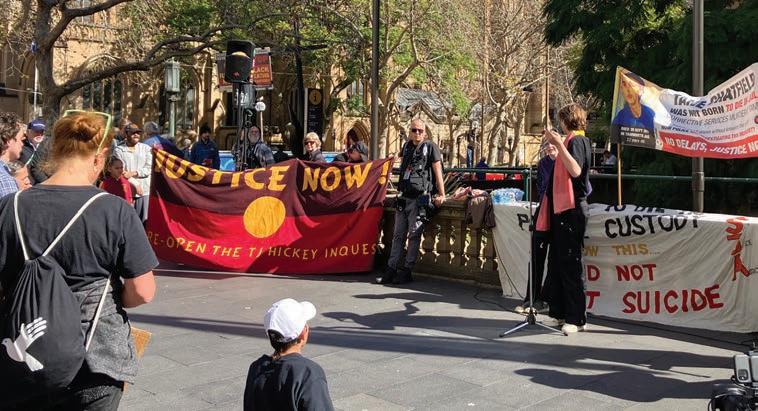
The Black Lives Matter rally, organised by Sydney University’s Autonomous Collective Against Racism, alongside First Nations advocacy groups, has reignited action in opposition to the sustained mistreatment of Indigenous people by Australian law enforcement and health care systems.
Furthermore, advocates have called upon the Federal Government to implement all recommendations from the 1987 Royal Commission into Aboriginal Deaths in Custody. Wiradjrui student Ethan Lyons spoke out on providing better support and protections for Indigenous youth.
In a statement prior to the event, Lyons said, “First Nations young people deserve to leave the house in the morning without their families worried if they will come home at the end of the day.”
“We deserve to be curious, creative and live out our youth, just as any
other young person, without being threatened by police and correctional services.”
Lyons also criticised the impact of “climate devastation” as being a significant cause to the loss of Indigenous cultural heritage and practices.
First Nations advocate, Paul Silva, spoke out against the lack of dignity given to Indigenous people in custody and called for police officers to be held accountable.
“There is never any accountability. Hold the corrective services accountable, hold the doctors and nurses accountable,” said Silva.
5 police officers restrained him and injected him with a sedative while in custody.
Calling out systemic challenges, Silva questioned, “where are the good cops keeping the bad cops accountable? There aren’t any because they fall under the blue line.”
Silva’s uncle and Dunghutti man, David Dungay Jr, was killed in 2015 when
RFNSA SITE NO. 2011007
1. The proposed facility consists of the addition of new Optus and Vodafone equipment and associated works as follows (including 5G):
• Removal of three (3) existing antennas
• Installation of three (3) panel antennas (no more than 2.7m in length)
• Installation of three (3) Nokia active AAUs
• Installation of one (1) GPS antenna (Nokia)
• Installation of three (3) new RRU mount
• Replace twelve (12) RRUs with Twelve (12) Nokia RRUs
• Replace four (4) antenna pipe mounts with four (4) antenna pipe mounts
• Provision of future active antenna units and remote radio units for utilisation
• The reconfiguration and relocation of existing technologies and the addition of new technologies for 3G/4G/5G systems
• The removal and installation of ancillary equipment including but not limited to transceivers, amplifiers, antenna mounts, mounts, cable trays, feeders, cabling, filters, combiners, diplexers, signage, and other associated equipment on the facility and in the existing equipment shelter
2. Optus & Vodafone regards the proposed installation as a Low-impact Facility under the Telecommunications (Low-impact Facilities) Determination 2018 (“The Determination”) based on the description above.
3. In accordance with Section 7 of C564:2020 Mobile Phone Base Station Deployment Code, we invite you to provide feedback about the proposal. Further information and/or comments should be directed to: communityconsultation@ventia.com or Level 1, South Tower, 10 Browning Street, West End QLD 4101 Australia by COB Thursday, 28 September 2023.
Along with law enforcement and correctional services, many spoke out regarding the lack of accountability from healthcare systems involved with Indigenous deaths.
At the rally, the family of KamilaroiDunghutti man Ricky “Dougie” Hampson Junior, called for better support for Indigenous communities within healthcare systems.
In August 2021, Hampson Junior died
from perforated stomach ulcers shortly after being discharged from a Dubbo hospital who allegedly accused him of being high.
His father, Ricky Hampson Senior, spoke at the rally saying, “this health system is killing us too and not many people are talking about it.”
“They [colonisers] have faded our skin but they won’t fade what’s inside here,” said Hampson Senior whilst tapping his heart. The family are advocating for systematic change within the industry, including Aboriginal liaison officers and greater education measures for staff to provide culturally appropriate care.

WestConnex Stage 3B, M4-M5 Tunnel links with Victoria Road, Rozelle NSW 2039 Optus Vodafone Ref: 220198, www.rfnsa.com.au/2040042
1. The installation involves the establishment of Optus and Vodafone network coverage within the tunnel systems linking Victoria Road and the M4-M5 links, through co-locating with Telstra on the distributed antenna system. The works will take place in the communications hub building between City West Link and Lilyfield Road and includes:
• Installation of twelve (12) equipment racks within the mobile phone IT room
• Installation of two (2) new GPS antennas on the rooftop of the communications hub
• Ancillary equipment and works including cabling between the components and AC power works that are necessary for the operation and proper functioning the facility, or otherwise for the sole purpose of ensuring the protection and safety of the facility and persons or property near the facility
• Any other activity necessary for the installation
The purpose of the installation is to provide Optus and Vodafone 4G and 5G network coverage to the tunnels between Victoria Road and the M4-M5 motorways.
2. Optus and Vodafone regard the proposed installation as a low-impact facility in accordance with the Telecommunications (Low-impact Facilities) Determination 2018 (Amendment 1, 2021) based on the description above.
3. Notification is being undertaken in accordance with Section 7 of Industry Code C564:2020 Mobile Phone Base Station Deployment.
4. Members of the public may obtain further information on the proposed work, and we invite you to provide written comments about the proposal. Further information and/or comments should be directed to Vodafone’s representative c/- Elliot Nelson, Catalyst ONE Pty Ltd; phone: 02 4022 9533; email: consultation@catalystone.com.au and post: PO Box 1119, Crows Nest NSW 1585 by 5:00pm 29 September 2023.
where are the good cops keeping the bad cops accountable? BLM activists gathered at Sydney’s Town Hall. Photo: Robbie Mason
Content warning: This article contains mentions of hazing and sexual assault.
The University of Sydney (USyd) has published a standalone report on university-related sexual misconduct for the first time, providing startling proof that sexual incidents are increasing at the historic sandstone institution.
The Annual Report on Sexual Misconduct, released on Monday 28 August, reveals there were 121 incidents of sexual misconduct involving university staff and students in 2022.
Now students and anti-sexual assault activists are airing their concerns.
Sharna Bremner, founder and director at End Rape on Campus (EROC) Australia gave “big kudos” to Sydney University “for actually releasing the report”.
Following the ground-breaking 2017 Change the Course report, published by the Australian Human Rights Commission, 39 Australian universities agreed to improve transparency in sexual misconduct reporting. As recent media reports have revealed, however, only one quarter of those universities are publicising information on campusrelated sexual violence in a clear manner.
“We’ve seen university administrators and management shirk their responsibility across the board for a very long time,” Bremner said.
“Universities have generally viewed sexual assault and harassment as PR problems to be managed as opposed to issues of student and staff welfare.”
Rates of sexual violence on campus and at university-affiliated events are almost certainly far higher than the Sydney University report suggests due to underreporting. According to the 2021 National Student Safety Survey (NSSS), only 5.6 percent of student sexual assault victims and survivors reported the incident to their respective university.
Iggy Boyd and Alev Saracoglu, Women’s Officers at the USyd Students’ Representative Council (SRC), said the report is “alarming” proof of the “failing of university management”.
“It doesn’t come close to capturing the real extent of sexual violence on campus”, they stated on behalf of USyd’s Women’s Collective “Instead it paints a picture of the inadequacy of the sexual violence reporting systems available to students on campus.”
To emphasise the point, Boyd and Saracoglu cited figures from the 2021 National Student Safety Survey (NSSS) which showed that 1.5 percent of Sydney University students had endured sexual assault in the 12 months prior to the study.
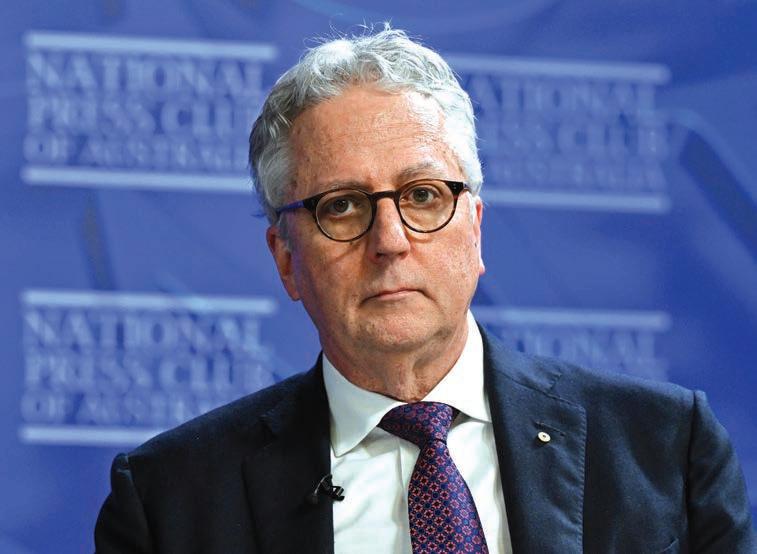
“That’s 1161 incidents of sexual assault. Very few students were on campus in that period due to COVID, so now that students have returned these numbers will absolutely have increased. The uni receiving only 121 reports of sexual assault and sexual harassment on campus demonstrates just how few students are reporting their incidents on campus to the university.”
While Bremner is congratulatory of the efforts of Sydney University management, she told City Hub that she wants to see the university go further in future reports. Noting that the report includes references to penalties for perpetrators, she expressed concern that the document does not specify the nature of those repercussions.
“It’s really important that that kind of information is made public too because it helps to foster trust in the university’s reporting processes. It also sets a really clear message about how seriously the university takes this.”
Like Bremner, Audrey Mims, Chair of the STOP Campaign, expressed frustration that reports continue to highlight an already-proven issue while there is little tangible action and few signs of industrywide reform.
“Students and staff have been raising the alarm for years,” Mims stated.
“What is most frustrating for us as student activists – many of whom have lived experience of sexual violence in tertiary learning contexts – is that while institutions give platitudes about ‘needing to do better’, this doesn’t translate into tangible, peer-led primary prevention work.”
Mims, Bremner, Boyd and Saracoglu all told City Hub that they want to see federal oversight of universities and the establishment of an independent, expert-led taskforce.
In July this year, a wide range of student representative bodies, advocacy organisations and women’s support services penned an open letter to the Albanese government demanding the implementation of an independent authority.
“We see the only real solution to this being to make education free and to forgive student debt.”
According to USyd’s Annual Report on Sexual Misconduct, students are the most common target for sexual violence at Sydney University. Over 100 of the complaints and disclosures came from current students.
Boyd and Saracoglu from USyd’s Women’s Collective emphasised the prevalence of sexual misconduct with clubs and societies and student accommodation spaces.
They described the university’s residential colleges – long criticised for their elitism, lack of diversity and brazen anti-social behaviour – as “hubs for misogyny and sexual violence”.
A series of high-profile investigations and reports have exposed an ingrained culture of disrespect and harmful hazing rituals within residential colleges at USyd. Despite a commissioned one million dollar review laying bare the failings of the college system in 2017 – the Broderick Review into Cultural Renewal at Residential Colleges – and attempts at reform, USyd colleges have continued to make headlines for the unsavoury behaviour of enrolled residents.
Only just this year, in February, the USyd student newspaper Honi Soit reported that students from St Andrew’s College had engaged in sexist, homophobic and intimidating behaviour during Welcome Week events. The accusations resulted in the expulsion of St Andrew’s students from inter-college events.
Bremner explained, “it has become very apparent to us that without oversight and without consequences, universities are not willing not act on this.”
Only weeks ago, Universities Australia, the peak body representing the nation’s tertiary education sector, scrapped a $1.5 million communications sexual consent campaign, allegedly under pressure from a minority of unhappy university chiefs. Critics have demanded a radical overhaul of the university sector and highlighted the systemic factors contributing to rising sexual misconduct within university spaces.
The USyd Women’s Collective stated, “among the root causes of sexual violence on campus is the corporatisation of the university which consistently puts profits before the wellbeing of staff and students, and which intentionally under reports for fear of being labelled a ‘rape university’, impacting its branding and student intake.”
Jenny Leong, Greens Member for Newtown and Spokesperson for Women, told City Hub, “like too many universities, Sydney University has a long history of toxic behaviour and sexual violence on campus, and it’s deeply disturbing that reports of assault have increased.”
For years USyd students have campaigned to “abolish the colleges” and replace them with affordable student housing. But calls for “real action” have “fallen on deaf ears”, the USyd Women’s Collective stated.
MP Jenny Leong said the Greens back calls from student activists to abolish the colleges.
Boyd and Saracoglu concluded, “if USyd wishes to address sexual violence on campus in a meaningful way, they will need to work towards abolishing the Colleges, ending third party management of student accommodation and only ensuring Clubs and Societies all have much more expansive consent training and education programs run by students.”
Students and staff have been raising the alarm for years
Australians have always lapped up American culture and looked to the USA for validation of our own cultural success stories.
American movies, music, theatre and literature have all found a welcome second home in Australia, often idolised and stacked up against local artistic output for critical comparison. If it’s a sensation in Hollywood or New York, then bring it on down as it’s bound to work here.
Whilst we have gone a long way in resisting American cultural imperialism over the past few decades, often promoting our own unique events, along comes South By South West in October. The annual music, film, and interactive media conference that’s been a huge success in Austin Texas is coming to Sydney and a platinum ticket for the week will set you back a mere $1,695.00 – at least that’s in good old Aussie dollars.
If SXSW gets a foothold, the inevitable question is surely: when do we get our own Burning Man? Forget about the mud bath fiasco that took place in the wilds of Nevada recently, the time is ripe for our own version of this remote US Festival.
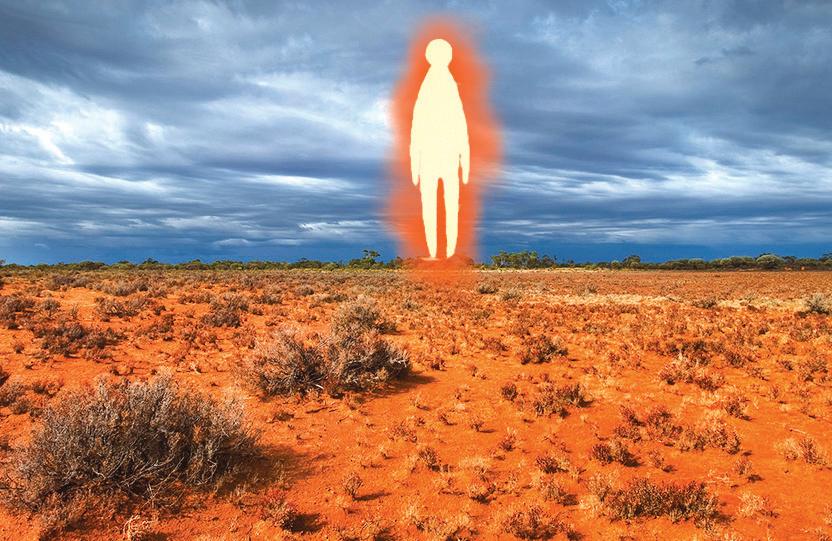
It’s a celebration where up to 80,000 free thinking young people, discarding their worldly possessions (all bar their $100,00 RVs), gather for nine days of music, meditation and assorted bacchanalian pursuits.
Let’s face it, a great slab of this continent is desert and we have no shortage of totally hostile locations. For starters, we should ban all campervans
2825 Darlinghurst: 227 Victoria Street, Darlinghurst NSW 2010 (RFNSA 2010023)
The proposed facility consists of the addition of new equipment and associated works, including 5G, as follows:
• Removal of existing Vodafone antennas and equipment
• Installation of three (3) panel antennas, 2.7m long, on new and existing headframes
• Installation of three (3) panel antennas, 0.8m long, on new and existing headframes
• Installation of ancillary equipment including up to fifteen (15) remote radio units, antenna mounts, steelwork, cabling and works within the existing equipment shelter
1. Vodafone regards the proposed installations as Exempt Development under the SEPP (Transport and Infrastructure) 2021, based on the description above.
2. In accordance with Section 7 of C564:2020 Mobile Phone Base Station Deployment Code, we invite you to provide feedback about the proposal. Should you require further information or wish to comment, please contact Rohan Montgomery at Indara, 02 9495 9000, community@indara.com or Level 1, 110 Pacific Highway, St Leonards NSW 2065 by Friday 29th September 2023. Further information may also be obtained from www.rfnsa.com.au/2010023.
and RVs and make entry by camel only. Australian has hundreds of thousands of the feral critters and they could be rented out for the week. Definitely no mobile phones, hand held video games, toilet paper, tins of Spam and spray on deodorant. Burning Man Downunder should be a slap in the face to those American wusses in Nevada who luxuriated in the air conditioned comfort
of their homes on wheels, prior to the heavens opening.
We should also ban all the counter culture parasites who inevitably flock to these events, flogging their alternative medicines, tantric massage and spiritual enlightenment. A huge sign announcing “THIS IS A GURU FREE EVENT” would greet festival goers as they entered the site aboard their trusty dromedaries.
When it comes to the actual “Burning Man”, I would not allow personal preferences to intrude – so igniting a sixty-foot Peter Dutton would sadly be out of the question. And does the actual effigy have to be gender specific or even set alight, shamelessly paralleling the American version? Pyromaniacs might be disappointed but why not go for a slow smouldering version, one that might emit an eery haze right through until next year’s event – indicative of the constant rise in global temperatures.
Burning Man? – nah, the Yanks can have that one. The Smouldering Big Thing has a real Australian ring to it, along with the Big Pineapple and the Big Lobster. And yes, Eskys will be allowed!
1. The site at which this works is being undertaken is located at 272-282 Clovelly Road COOGEE NSW 2034.
2. The upgrade comprises of the works and installation of one (1) new panel antenna (not more than 2.8 metres long) on an existing support pole; ancillary equipment includes four (4) remote radio units (RRUs) and two (2) dual rejection filters attached to a support pole; associated new cabling including fibre and power (internal and external); removal or relocation of existing equipment; works within the existing equipment shelter; and any other associated works necessary for the operation and functioning of the facility.
3. Optus regards the proposed works as a low-impact facility under Telecommunications (Low-impact Facilities) Determination 2018 based on the description above.

4. The proposed infrastructure will comply with the ACMA EME regulatory arrangements. An EME Report and further information can be obtained from www.rfnsa.com.au site number 2031008.
5. In accordance with Section 7 of C564:2020 Mobile Phone Base Station Deployment Code, we invite you to provide feedback about the proposal. Further information and/or comments should be directed to: CPS Technology & Infrastructure, (02) 9300 1700, planning-vic@cpstech.com.au by 5.00pm on Friday 29 September 2023
 BY RITA BRATOVICH
BY RITA BRATOVICH
“This is my fourth play of the year and I think, well it’s not bad for an old girl,” says Giblin with a smile, referring to the upcoming Venus and Adonis by Sport For Jove, in which she will play Queen Elizabeth I. She has just wrapped up the highly acclaimed, The Weekend, at Belvoir Theatre. Earlier this year she was one of the spritely Venticelli in Amadeus, then Mrs Venable in The Ensemble’s Suddenly, Last Summer “There’s a whole new sort of energy in the business,” says Giblin, describing how the theatre landscape has changed in recent years. “There wasn’t a lot of work for older women. Well, that has really changed. Suddenly there are many more roles now for women — and older women — and this is not just in film and television, there’s much more in theatre.”
Not only are there more roles, but those roles are diverse and meaty, they go beyond the token staid grandmother and address topics other than nursing homes and mortality.
“We’re a force to be reckoned with and we have wisdom and still massive energy, and that’s what I’m glad is being celebrated,”says Giblin.
In The Weekend, Giblin’s character is feisty and at one point, does a little dance. In Amadeus, Giblin donned a skin tight, ornately patterned onesie and flitted about the stage. It’s hard not to comment on her surprising fitness, but it makes Giblin bristle.

“I mean, this has always annoyed me, the assumption that after a certain age things happen to slow you up. Well, I would say I’m more energetic now than I was in my 20s and 30s. I’ve got more more vibrancy, more energy…we make an assumption about people of a certain age, that they start to decline. Well, I certainly haven’t experienced that”
Giblin, who was born and grew up in Tamworth, originally showed great
promise as a ballet dancer, but at 17, she decided to pursue acting instead and headed to Sydney to study at the elite NIDA.
Her career began in 1971 and by the mid-seventies she had firmly established herself in television and on stage. One of her earliest roles was

in the notorious soap series, The Box From there Giblin had a 12-year run of consistent work with Australian TV powerhouse, Crawford Productions, which produced many of this country’s most iconic shows.
One of Giblin’s most memorable TV roles was as Patricia “Pat the Rat” Hamilton in the immensely popular Sons and Daughters. She replaced Rowena Wallace in the role, with their slight difference in appearance being explained by the character’s having undergone plastic-surgery overseas then assuming a false identity. (Only in soapies!)

Even more bizarre was Giblin’s recent appearance as Martha Stewart on Home and Away. The character had hitherto been presumed to have drowned.
“I’m now going in to play Elizabeth I… the virgin queen,” Giblin says with a cheeky hint of irony.
Venus and Adonis is an original play written and directed by Damien Ryan and based on the Shakespeare poem by the same name. It’s set in the court of Queen Elizabeth I during the Black Plague when towns were in lockdown and theatres were closed. A
She established her career in the early 1970s, becoming a favourite on TV, film, and on stage. Now fifty years on, Belinda Giblin is still in high demand and working hard as ever.
I would say I’m more energetic now than I was in my 20s and 30s.Photo: Mark Dickson Photo: Supplied Photo: Daniel Boud
select group of performers, including Shakespeare’s theatre company, The King’s Men, were allowed to put on shows for royalty within the court. Ryan wrote the play during the COVID lockdown, in fact, that was his inspiration. He drew together a cast and they made a film version of the play. It was then made available via streaming.
The same cast has been brought together again for this new stage production. The premise might sound dry and solemn, but that’s far from the truth.
“Damien Ryan, who is undoubtedly the best Shakespeare director, I think, in this city, he’s written the most extraordinary play. It’s dirty and funny and witty beyond belief, and very clever,” assures Giblin.
The play is very meta: Venus and Adonis is about a group of actors who are putting on Shakespeare’s play, “Venus and Adonis”. Therein lies much of the humour.
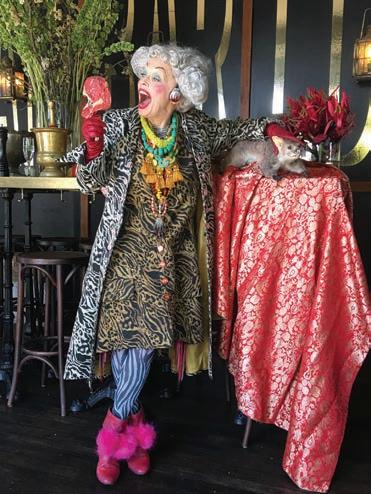
At the centre of the story is Aemilia Lanyer, a female poet who is reputed to have been the Dark Lady of Shakespeare’s sonnets, and his mistress.

“But he stole a lot of her work,” says
Giblin. “Because, you know, women couldn’t be writers and couldn’t be published at that time.”

Lanyer actually did become the first female writer to be published in England,
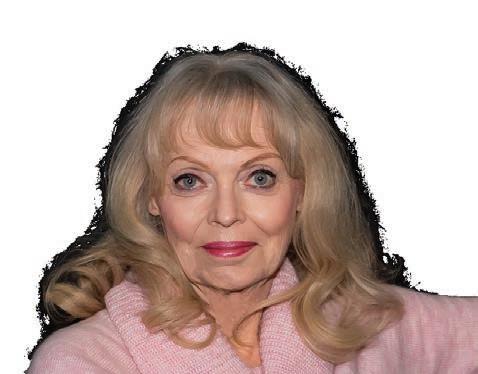
quite likely because of her connection to the Queen.

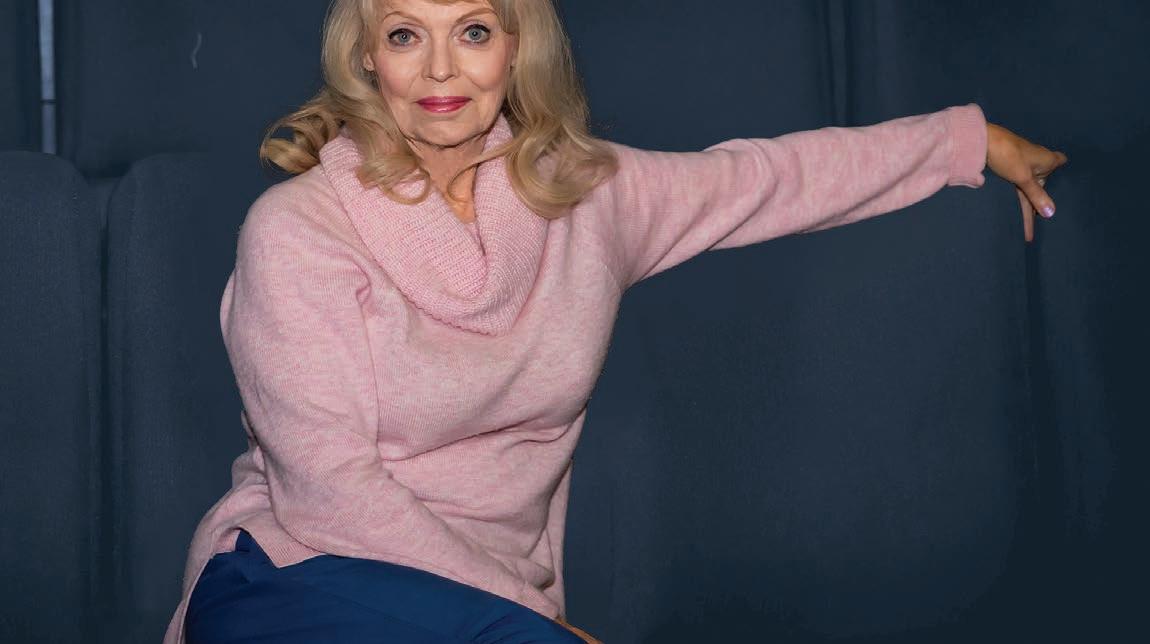
Adele Querol plays Lanyer, who in turn plays Venus. Anthony Gooley plays Shakespeare and Jerome Meyer plays Nat Field, an actor who is accustomed to playing female roles (as was the custom) but has now been asked to play Adonis. “He’s used to playing women and now he has to play a sexy man, and he says ‘I can’t do that!’” laughs Giblin. “So it’s all about gender and appropriateness. I think audiences will absolutely love it because I still watch the film and laugh my head off.”
Ryan himself is in the play (along with his wife and two sons) so his imprint is well and truly on it. And that is far from a bad thing, according to Giblin.
“It’s Damien’s writing that completely wooed me to this play.
I’ve never worked with him before. So when I did the film I was so excited to do it and I wasn’t disappointed. And Damien’s sets are always …he’s a very, very inventive director. And he never stops, he’s kind of organic… he doesn’t stand on the outside saying do this do that, he’s gets right in there, you know. He encourages your imagination. And that’s really exciting to work with.”
He encourages your imagination. And that’s really exciting to work with.
(See p.31)
BY RITA BRATOVICHWicked opened in Sydney for its 20th anniversary season, and if audience response is anything to go by, the production has been green-lit (excuse the pun) for a very successful run. Visually, this is a sumptuous offering. From footlights to proscenium and beyond, there is a design delight for the eyes to marvel at. A large pterodactyl-like dragon with glowing red eyes protrudes from the top of the stage and comes alive in the opening number. It’s an example of the technical wizardry (again, ‘scuse pun) that makes Wicked one of the most extravagant and complex shows to mount.
The entire cast is exceptional, with
Whilst not hugely accurate in the telling of the Greek Classics, there’s certainly no shortage of saucy storytelling and physical fun to be had in this high wire, athletically exhausting, acrobatic feast for the senses!
If you are into either acts of spectacular strength, laugh out loud physical comedy or gravity defying stunts that will leave you on the edge of your seat, this show delivers all that and more.
The show can appear a little rough around the edges, however, if anything, the limits in wardrobe budget and staging add to the charm of this piece and encourages the viewers to connect with the performers even more.


One of the strengths of this show is that
Courtney Monsma as Glinda and Sheridan Adams as Elphaba standouts. Monsma’s Glinda is very much like Legally Blonde’s Elle Woods: naïve, vain, self-absorbed, popular. Glinda also has the dragon’s share of the good one-liners, all of which land.
Adams is intense and engaging as Elphaba. From her first appearance on stage she has the audience in the verdant palms of her hands. Elphaba gets the hold-your-breath clutch-your-program moments including the show-stopper, “Defying Gravity”.
Liam Head is very dashing as Fiyero, who first comes off as conceited and shallow, but later proves himself to be a veritable, if somewhat flawed, hero.
Shewit Belay plays Elphaba’s wheelchair-
bound half-sister, Nessarose, an underdeveloped, problematic character who has an inexplicable arc. It’s a shame because Belay clearly has more to offer than she is given opportunity to show in this role. Boq (Kurtis Papadinis), on the other hand, has a bit more chance to shine on stage (in terms of performance, that is – his character is reproachable) and Papadinis does shine.
Robin Nevin is absolutely priceless as Madame Morrible. Her stage presence,
her precision timing and that luscious Shakespearean voice validate her status as Australian theatre royalty.
As the Wizard, Todd McKenney capitalises on his popularity with the crowd to really ham it up. He is great fun, and there is a discernible rapport between he and Nevin that makes even the most subtle, implicit visual gag land with both feet.
Until December 31, Sydney Lyric, 55 Pirrama Rd, Pyrmont, wickedthemusical.com.au

Laura Murphy (music and lyrics), Blake Erickson (book) and Jay James-Moody (book and director) have taken one of the most explosive moments in Australia’s political history and compressed it into three hours of hectic frivolity.
It’s an ambitious endeavour and the work itself has gone through quite a gestation. The result is a mixed bag: it’s a bit long, uncertain of what it wants to be, and sometimes lacking in nuance. At the same time it is frequently hilarious, entertaining and filled with subtle surprises.
underscores one of the main issues with the script of The Dismissal, to wit, there is an awful lot in it. There are a lot of characters, a lot of events, a lot of details and a lot of songs. That’s all fine if the show is happy to be a light farce, but the occasional introspective ballad and the tacked on, overly earnest messaging at the end suggest that it was aiming for more.
it doesn’t take itself too seriously at all, and that helps construct it’s definite, yet impious appeal.
GODZ has already done the rounds of a few festivals and won a rather impressive slew of awards and it’s not surprising why. The high level of intimacy and mutual trust the cast must have in performing so closely is a subtle strength within the piece; they can ad lib around script and still hit crucial marks and keep crucial timing for dare devil aerial choreography.
This show isn’t easy to define and really does have to be seen to be believed.
Until October 1, The Vault, Spiegeltent Festival Garden, Entertainment Quarter, Moore Park sydneyfringe.com
Ostensibly focused on the infamous ousting of Prime Minister Gough Whitlam by the Governor General, Sir John Kerr in 1975, the scope of this musical is much wider, both in terms of timeline and commentary. That
There is brilliance, though. The performances are all solid,This is a new Australian show with quintessential Australian content, written by, performed by and produced by an all-Australian team. It’s refreshing, vibrant, relevant and in the end, loads of fun.
Until October 21, Seymour Centre, cnr City Rd and Cleveland St, Chippendale
www.seymourcentre.com


The Marvellous Elephant Man is audacious, rambunctious, colourful and utterly without scruples. It’s a crazy, fast-paced pantomime filled with punchy one-liners, fun songs, deliciously histrionic performances and very blue humour, although it very likely strays onto the wrong side of good taste when it comes to the subject matter.
The musical is loosely (very) based on the true story of Joseph Merrick who was born in 1862 and lived for a mere 27 years due to a rare condition that left him with extreme physical deformities which earned him the unkind moniker, “the elephant man”.
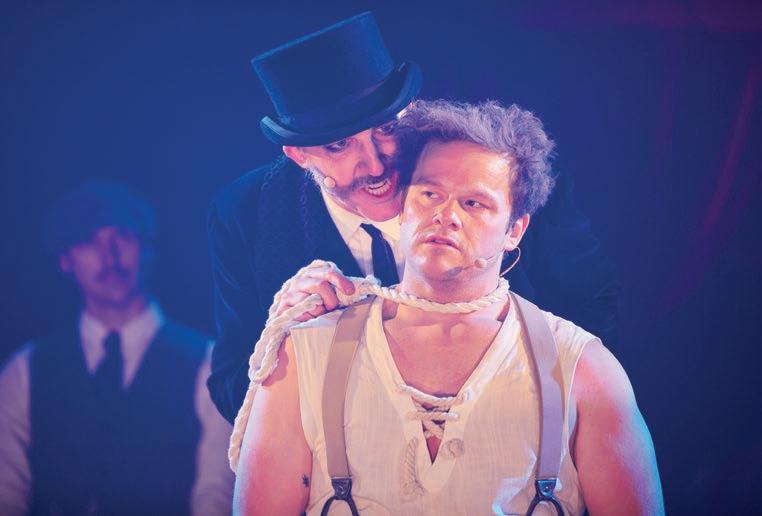
In this musical production, Merrick has not been given any prosthetic enhancements at all.
The choice not to depict Merrick with any of the well-recognised deformities is questionable. Yes, it circumvents any
unintentionally comical special effects make-up and yes, it allows audiences to relate to Merrick as a real person, not a freak. On the other hand, it unfairly gives licence to the unmitigated mockery because we don’t actually see, and therefore don’t acknowledge, Merrick’s debilitating disability.
The show is at times, hilarious, with witty lyrics, toe-tapping tunes, simple but effective production elements and entertaining choreography. At other times, it’s a little too much.
Marc Lucchesi, who co-wrote the show (with Sarah and Jayan Nandagopan), plays the Ringleader and several other characters. He is boyishly charismatic and pushes the action.
Kanen Breen is a villainous, boo-evoking Dr Frederick Treves. Breen delivers great vocal, facial and physical comedy and knows how to play a crowd.
Annelise Hall is the Disney-esque Nurse
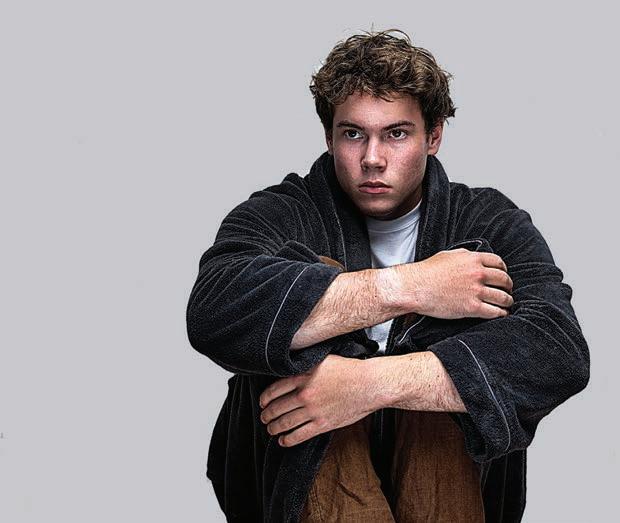 BY RITA BRATOVICH
BY RITA BRATOVICH
When The Disappearance played in May this year as part of the Actor’s Benevolent Fund benefit night, it was clear it had potential for a full season run. Critics and audiences were ecstatic in their response.
The Disappearance is a re-working of the 1973 novel by Kin Platt, The Boy Who Could Make Himself Disappear, which itself inspired the British film, Baxter. Both the book and the film have informed this staged version.
The story centres on a young teenage boy living in America who has a severe speech impediment which not only gives him personal grief but evokes unhelpful intercessions from his parents. Said parents are in the throes of a crumbling
marriage and further destabilise their son with a planned move to Australia. The boy’s mental health quickly declines until he reaches breaking point and decides to “disappear”. His therapist and two genuinely concerned neighbours seem to be the only people that can reach him and offer some hope for resolution. Directed by Les Solomon, The Disappearance features a cast of young emerging performers alongside established actors including Kath Gordon, Rebecca Matthews and Mo Lovegrove . In the role of the boy is rising star, Gordon Vignelles.
October 10 – October 22, Chippen Street Theatre, 45 Chippen St Chippendale

www.trybooking.com/CKLMY
Hope. Hall is iridescent on stage, aware that she is a typecast golden-haired heroine and playing it with a kind of knowing wink.
Ben Clark plays Merrick as wide-eyed, cowering, vulnerable. He is almost inconsequential on stage – until he sings. Clark has a powerful, gorgeous voice that repeatedly evokes cheers of
appreciation from the audience midsong.
This show is really, really funny (if you enjoy toilet humour) and at the same time, offensive at a level that is tone-deaf to current social consciousness.
Until October 1, Sydney Spiegeltent, Entertainment Quarter, Moore Park, sydneyfringe.com
Prepare to be captivated as Dance Makers 2.0 (DMC), Australia’s premiere collective-led dance company, presents Big Dance 2.0 at Riverside Theatre Parramatta next month.
A decade since its inception, DMC returns to the stage with a fresh take on their iconic inaugural production, Big Dance in Small Chunks, which featured a curated tasting platter of micro performances.
To mark the 10th anniversary milestone, the upcoming production will re-imagine the pieces in Big Dance in Small Chunks, with nine dynamic dancers, singing, a boxing ring, a live stream and a snake, all promising to be funny, touching, challenging and celebratory.
Carl Sciberras from DMC shared his enthusiasm saying, “I couldn’t be more
excited about the next generation of dance in Sydney. This project marks a critical milestone in our history as a company breaking new ground and doing things differently.”
Big Dance 2.0 showcases the talent of dancers and choreographers from across New South Wales, including renowned Australian Dance Award winner Jana Castillo, emerging First Nations dance artists Jye Uren and Amy Flannery, and Eliza Cooper, this year’s Sydney Dance Company New Breed choreographer.
This ground-breaking event promises a unique blend of dance styles and as Carl Sciberras puts it, it gives hope for the future of dance in Australia.
October 12-14
Riverside Theatres, cnr Church and Market Sts, Parramatta
www.form.org.au/big-dance-2-0
 BY ISABELLA GIBBS
BY ISABELLA GIBBS
The monumental South by Southwest (SXSW) mega festival will be more south than it’s ever been when it heads to Sydney this October. The inaugural SXSW Sydney marks the first time the Texas-based organisation has held an event of this scope away from its home turf, and it is set to be the largest event of its kind in the Asia-Pacific region. The Sydney edition of the famous ‘festival of festivals’ will take over the city for a jampacked week of musical performances, gaming competitions, industry leader talks and debut film screenings.
Attendees can expect ground-breaking sessions and unique opportunities to forge connections with some of the world’s leading thinkers, performers, and industry professionals.
The program features an impressive line-up of more than 400 diverse artists including home-grown up-and-comers and international performers representing a range of genres.
Over 700 thought-leaders and industry greats will take the stage, with big names including Coachella CEO Paul Tollett; fashion icon Tan France of Fab Five fame; Cal Henderson, the Co-Founder of Slack;
For more info and to purchase passes, visit: sxswsydney.com
BY KELLY O’HAREThe Powerhouse Museum has unveiled its latest exhibition, 1001 Remarkable Objects , an aweinspiring display of rich culture derived from various applied arts disciplines, including fashion, social history, music, and more. While most exhibitions typically feature around 100 objects, 1001 Remarkable Objects blows this figure out of the park, solidifying itself as one of the most extensive, large-scale exhibitions to date.
The number of objects on display, a theatrical 1001, is a nod to the members of the theatre world involved in the design and production of the exhibition. Led by Leo Schofield AM, curatorium experts Ronan Sulich, Mark Sutcliffe, and Eva Czernis-Ryl embarked on the meticulous selection of 1001 items from the pool of half a million housed
within the Powerhouse Museum’s collection. Each chosen object was deemed ‘remarkable’ due to its rarity, visual appeal, social history, or an ability to invoke wonder.

This ground-breaking exhibition celebrates the history and relevance of the iconic institution, The Powerhouse Museum, and its collection’s sheer scale and breadth. The curated objects are thoughtfully presented and displayed by exhibition designers who have skilfully arranged the objects into 25 individual rooms, each with an underlying theme of nature, power, movement, or joy. A distinct mood is exuded from room to room, ranging from playful and joyous to serious and sentimental as the viewer takes a glorious journey transcending time.
Until December 21, Powerhouse Museum, 500 Harris St, Ultimo powerhouse.com.au
BY MARK MORELLINIBrick Burger are opening a pop-up restaurant right in the heart of the city, and eating the burgers is just the start of the fun! When you walk into the restaurant you’re surrounded by building bricks – on the walls, on the floor and on every table. You’ve come to the right place if you love playing with building bricks!
There are three slider options on the menu: the Chick Bricks, the Moo Blocks and Tetris Delite (vg) all served with a side of chips. The brick (bun) moulds are custom made and baked from a baker sourced locally and they come in four colours. Adult beverages include the Tropical Brick, a must for lovers of cream-based cocktails.
Once the eating is complete the games commence, with brick construction and trivia competitions and prizes for all the winners. The staff are friendly and knowledgeable about all the items on the menu and are also highly skilled with the building bricks!
This is a perfect outing for anybody who wants an alternate burger dining experience without eating and then making a run for it. Perfect for family outings, for young mates who want to get together to enjoy a burger and a drink, and even for the much older who’d like to revisit their childhood!
October 14 & 15, World Square, Unit 6, Level 1, 644 George St, Sydney explorehidden.com

For the first time in the Surry Hills Hollywood Hotel’s 80 year history, the pub’s first floor will be open to the public for a sprawling wall-to-wall show titled Hooray for Hollywood showing the works of over 100 artists ranging from Archibald Prize winners to art students and their mums.

When Hooray for Hollywood closes at the end of September, a one person show titled Man Walks Into a Bar opens, featuring the work of David ‘Art’ Wales, the pub’s only ever artist in residence.
Doris Goddard, the Hollywood’s long term publican, bought the interwar period pub in 1978, and ran it as an extension of her lounge room with a mix of old style charm and song until shortly before her death in 2019.
The pub got its name due to its proximity to major cinema distributors in Commonwealth Street.
“The show is taking place in a beautiful old bar that was used by the boarders who lived there, and also the kitchen that Doris used,” David Wales, co-curator said.
“Her bedroom, living room and ensuite will be used as gallery space.”
Hooray for Hollywood has attracted some of the biggest names in the local art world, including Lindy Lee, Reg Mombassa, Peter O’Doherty, Susan O’Doherty and Blak Douglas, with John Safran being a late addition.

“I reckon Hooray for Hollywood is the first event of its kind…an art show in a pub where work by big established names hangs alongside young emerging artists,” Blak Douglas said.
“It totally captures the spirit of the Hollywood Hotel and Doris herself [and]
the art world needs more of that.” Hooray for Hollywood is being co-curated by MART collective, consisting of Rupert McEvoy and Alba Tijm.
“I went about it trying to broaden the age range of the show by bringing in two young curators, both in their early twenties, and they are both hot shot artists,” Wales said. Wales is known by many Sydneysiders as the creator of Guru Adrian, the cartoonish

figure which became the unofficial mascot for triple j in the mid-eighties, and who still figures in Wales’ work.

Man Walks Into a Bar is an accurate description of how David Wales became the Hollywood Hotel’s artist in residence. His studio space in Newtown was being
requisitioned by the owner, and one night he walked into the front bar at the Hollywood, his favourite Sydney pub.
“I first discussed the residency with Ben, the manager, and he asked what did I want to do?”
Wales said.
“I said that I wanted to get better as a painter and to do something for the community with a group show upstairs, and that I would like to do something for the pub by leaving a trace of art here.

“The show is essentially paintings that I have done over the past 12 months in the pub, and I set out to have a show that was as inclusive as Doris’ approach to running the pub.”
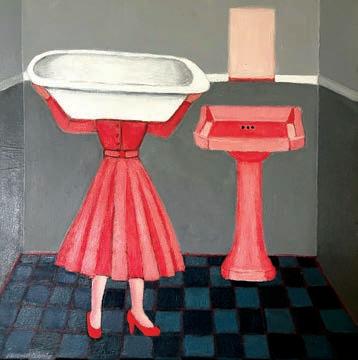
The art is priced from $30 to $15K, and as Wales said “There is something for everyone”.
HOORAY FOR HOLLYWOOD, September 15 - 30, daily 12-6pm MAN WALKS INTO A BAR, October 5 - 15, daily 12 - 6pm THE HOLLYWOOD HOTEL, 2 Foster Street, Surry Hills

With an acclaimed career that spans over a decade, Taylor Swift’s journey from country sweetheart to global pop sensation illuminates her dedication to the industry and commitment to control over her music and entire brand. At just 16, Swift released her self-titled debut album, showcasing her knack for storytelling through her lyrics. This album laid the foundation for her career, but it was the transition to pop with her Fearless and Red albums that took her to stardom.
Swift’s ability to transition between musical genres has been a key factor in her lasting popularity. She doesn’t just adapt to trends — she sets them. Her willingness to continually evolve
Back in the pre digital era of music magazines and free street press, there existed a cult of music writers of which musicians and their followers hung on every word written. This small coterie of writers were often egotistical, damaging and always self opinionated. In fact, it was that self opinion that won a writer followers, and equally as importantly, haters, and for much of this period Stuart Coupe was at the head of the pack.
Now, in his book Shake Some Action, Coupe recounts his immersion into the music scene from his early Launceston fan boy days to his wild, wild ride of some fifty years in the Australian music scene.

Getting his start on Adelaide street press magazines, while attempting to attend Flinders University, Coupe soon came to the attention of RAM, one of the two national music magazines in the late sixties and early seventies.
Seemingly in no time, Coupe finds himself at the epicentre of Australia’s booming rock music scene that is also attracting the top bands in the world.
Shake Some Action is essential reading for those who experienced the Sydney and wider Australian music scene over the last fifty years, as told by an insider who never lets his achievements overwhelm the story.
Shake Some Action by Stuart Coupe, Paperback, E-book and Audiobook, www.penguin.com.au
her sound and image to stay relevant has allowed her to connect with all audiences and remain timeless.
In 2014, Swift made headlines by removing her entire catalogue from Spotify, lashing out at the platform’s unfair compensation to artists. In 2019, she signed with Universal Music Group, securing ownership of her master recordings — a significant milestone for any artist. In doing so, she proved her determination to regain control over her artistry and financial future, a fight which has gained immense support from fellow artists. As she barks on her ground-breaking The Eras Tour, Swift proves that her legacy as a pop culture icon is firmly established.

This month join Bach Akedemie Australia as they present a blend of baroque and Indigenous Australian music in Bach A Child Under The Stars Renowned violin virtuoso, Madelenine Easton, shares the billing with two other early music composers, and contemporary Australian Indigenous composer, Troy Russell.
They’re joined by an orchestra of the finest early music components, including historical strings and woodwind instruments, and by a eight person choir across all four vocal ranges.
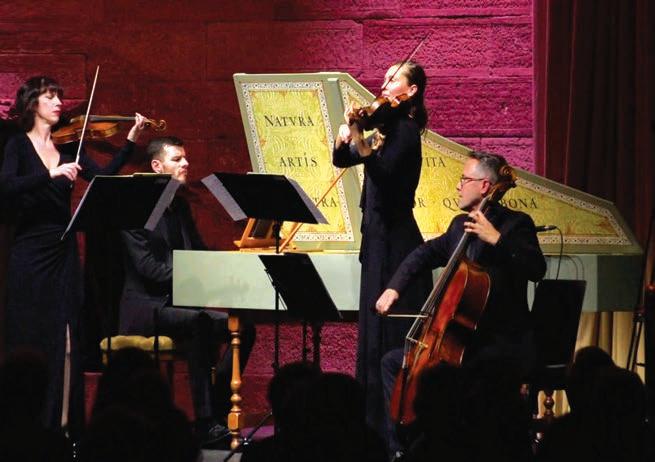
With their admiration to Johann Sebastian Bach and other significant European composers, Bach Akedemie Australia seeks to unite European culture with the newly commissioned work by Russell, Clans, inspired by the
Morning Star. Discussing the body of work, Easton says each piece within the program is inspired by the heavens.
“It is with a spirit of connectivity that we present this program of music inspired by the heavenly body that both J.S. Bach and the First Nations peoples of Australia have seen every day for millennia – the Morning Star,” explains Easton.
Russell’s original piece will be played alongside Bach, Tomás Luis de Victoria and Vincenzo Galilei. Music will also be paired with a special presentation from Professor Jonathan Bland-Hawthorn, Galileo, Bach and the western view of the heavens
September 22, 7:30pm, The University of SydneyGreat Hall, Science Rd, Camperdown www.bachakademieaustralia.com.au
When Damien Leith sang Roy Orbison’s crushingly beautiful ballad, “Crying”, on the 2006 edition of Australian Idol, he had judges and audience members doing just that. Through their tears they all knew they were witnessing a star in the making. Leith went on to win the series and garner a stalwart following of fans.

One of those fans was none other than Roy Orbison’s widow, Barbara, who contacted Leith.
He was of course, thrilled and deeply honoured, but there was also a sliver of dread. Leith was a huge fan of Orbison’s music and loved performing his songs, but he never aspired to be an impersonator. “I knew I didn’t want to copy Roy and I was concerned. I was initially worried that maybe that’s what she wanted,” he explains. “But it was quite the opposite. She was amazing. She really embraced the whole idea of, you know, interpreting the songs, finding ways of being true to them, but definitely adding my own stamp to them as well.”
Leith worked with Barbara to record an album, Roy: A Tribute to Roy Orbison, which was released in April 2011, only
months before Barbara herself died. The album went platinum in Australia and was universally acclaimed.

Leith takes the same approach with his show, Roy Orbison Orchestrated, as he did with the album, that is, it is a re-imagining of Orbison’s songs, done Leith’s way.
“These songs, because they’re so dramatic — quite a few of them have got massive builds where they start so small and then become humongous — they were crying out for strings,” says Leith.
but also come up with brand new segues, things that didn’t exist with Roy’s music. We can link them together so that when the audience come to the show, it’s not just a collection of songs, it’s a bit of a journey.” Greenhill has composed original transitions that allow one song to move seamlessly into another.
“I think those little things have added, you know, a whole other dimension to the show,” says Leith.
As well as a 28 piece orchestra, Leith will be backed by a band which will give the whole show dynamic ebb and flow.
Orbison’s songs were actually often written with arrangements for quartets or small ensembles.
“But we thought, wouldn’t it amazing to have a full orchestra. So that’s where the idea started.”
Leith wanted to take it to another level, however, so he contacted his good friend Emma Greenhill, a conductor and composer.

“The whole idea was, not only would we come up with orchestrations for the songs,
“Roy was a rocker. As much as he could do a big ballad, he could do great rock songs as well. The audience is definitely not just sitting there just ballad after ballad.”
Ticket sales so far are proving that Orbison’s music is still popular and that fans have faith in Leith honouring his legacy.
“I’m actually really, really thrilled,” says Leith with genuine humility.
“I think we’re in for a really good show.” September 30, State Theatre, 49 Market St, Sydney www.damienleith.com.au


This movie is inspired by true events and readers may be shocked that it occurred in a small town in Central Queensland back in 1994.

The story centres on Lara a young married woman who has been through much turmoil in her life. Her toddler was killed in a car crash and she never fully recovered. She started sleep walking and complained of seeing and hearing strange things.
Her husband believed that her ailment was spiritual not medical, so insisted that she be treated by a congregation of zealots and a merciless exorcist who would stop at nothing until the eviction of
the spiritual entities was complete – he warned “my methods may be excessive”. This movie is quite an eye-opener, frightening at times once the exorcism progresses. The gruelling process is detailed in length and may prove too difficult for the more sensitive moviegoers to watch. Was Lara really under demonic possession or merely crying out for help owing to her ongoing mental issues associated with the loss of her baby? The unpredictable finale is shocking and the accountability, or lack of accountability for the outcome, should anger audiences.
On Streaming services September 20
The bittersweet story of a 40 year friendship between two men set in the backdrop of the Italian Alps makes pleasurable and universally relatable viewing.
Pietro met Bruno on a family holiday to the Italian Alps which became an annual event. They bonded initially only for convenience but the relationship quickly flourished. Each summer they would meet and spend precious time together, but as they matured, life altered the friendship. The choices they made set them on different paths in life. Fifteen years elapsed before they reunited. Bruno was obsessed with living his life in the mountains as a farmer and Pietro lived in Nepal; both men were in relationships.
They decided to spend four months together building a summer holiday house high on the mountains in Italy.
This is an absolutely magnificent cinematic experience. Filmed entirely on location with endless awe-inspiring footage of long treks upon the mountains and the change in seasons. The natural beauty of the picturesque mountainous landscapes is also a central character in the story. The primary themes in this epic slowburning movie include self-discovery, love, loss, guilt, and the true meaning of friendship for life. 1/2
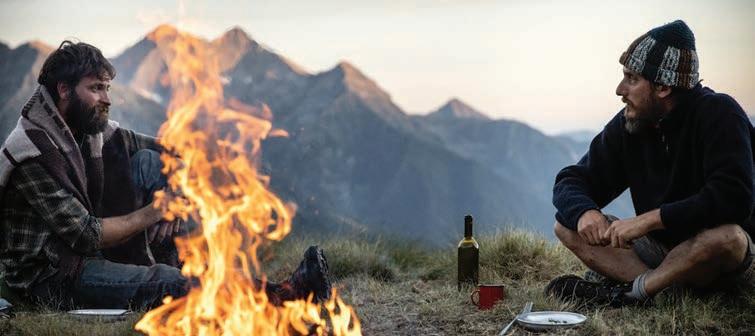
Screening at the Italian Film Festival
September 19 – October 18
italianfilmfestival.com.au
BY MARK MORELLINIThis cinematic offering from India is pure and simple storytelling. Samay is mesmerised by the magic of filmmaking when his father takes the family to the cinema. It’s a one off event, he explains, only because it’s a religious movie. Smitten, Samay skips school and continues to watch movies at the same cinema – he has bribed the projectionist with his mother’s delicious cuisine to watch the films free of charge. “Movies were created to fool people. The film world is filthy and sleazy!” utters Samay’s father who beats his son once he realises he has been going to the movies.

Samay is banned from ever attending again. With his friends in tow he builds his own primitive movie projector, stealing reels of film and watching movies in hiding. He learns the process of editing and creating sound, inventively using light, shadows, and pieces of film for his movies. Reminiscent of Cinema Paradiso, this enthralling movie explores a child’s dream of making movies, and a passion for making that dream come true. It also shows the effect of technology on society – how the the installation of modern movie projectors impacts small Indian cinemas in poor areas.
In Cinemas September 14
Scrapper is a small British comedy drama that won’t win any awards or won’t even make a ripple at the box office, but it’s a genuine feel good film that stands proudly aside from all the blockbusters.

It’s the story of Georgie (Lola Campbell), a 12 year old girl who lives alone in a unit. Her mother has passed away and she is extremely independent, finding solace with her young male friend.
Out of the blue her father, Jason (Harris Dickinson) returns stating that he wants to get to know his daughter. Georgie retaliates as her independence is threatened. At this point she becomes a scrapper – official definition being ‘a
person who fights or struggles against something, or to do something.’
This is a movie with a big heart. It’s funny and poignant at times with themes of friendship, grief, importance of family and reconnection resonating throughout. The script is astutely written with an even balance of humour and emotion.
There’s sweetness in the last scenes but no sugar coating. Once the movie has ended moviegoers may ponder whether this rekindled father/daughter bond realistically has longevity, as both characters admit they’ll most definitely “mess up a lot” in trying to build a relationship.
1/2
In Cinemas September 14
It’s been a bumper year for the Italian film industry, which translates to a bigger and better Italian Film Festival for Sydneysiders.
This year, festival attendees have 28 films to select from, 4 retrospective titles and a programme of shorts. Whether it’s hilarious comedies, dark dramas, or insightful documentaries there’s something for all tastes!
“Going to the cinema is still one of the most accessible and affordable activities […] It’s up to two hours of entertainment in state-of-art surrounds for the price of a panino!” enthused Festival Director, Elysia Zeccola.
With Italians returning to the movies in droves, there have been many box office hits and they will all be screening at the festival.

“So far this year the three top titles are: A Brighter Tomorrow, an entertaining comedy about filmmaking in the age of streaming giants; the slow burning drama, The Eight Mountains, a tale about friendship set against the backdrop of the Italian Alps; and the opening night movie, The Last Night of Amore, a taut thriller starring Pierfrancesco Favino.”
One movie which should draw huge crowds owing to the controversy that surrounds it is Kidnapped

“This compelling and heartbreaking film is based on a true story and it exposes an anti-Semitic period as well as hinting at the child abuse that occurred in the history of the Catholic Church, which the Vatican no longer denies,” explained Zeccola. “This gripping saga is a mustsee festival highlight, direct from Cannes where it screened in competition.”
Audiences who enjoy watching hits from the past should attend the screening of the Roberto Benigni classic comedy

Nothing Left to Do But Cry, the story of two best friends who are transported back in time to the 15th century.
Somebody Down There Likes Me is a wonderful documentary from cinematic master Mario Martone that should also prove to be a popular selection at the festival. “This is a tribute to the Neapolitan actor-director Massimo Troisi who died prematurely in 1994 and who is still a source of inspiration today. Troisi’s last film the beloved Oscar-winning classic, Il Postino will close the festival. The documentary paints a fascinating portrait of his life,” concluded Zeccola.
LA CHIMERA – Set in 1980’s Tuscany, we follow a lovesick Englishman who plunders Etruscan artefacts with a motley gang. Director Alice Rohrwacher takes audiences somewhere special with her unique and eccentric storytelling style. Stars Josh O’Connor.
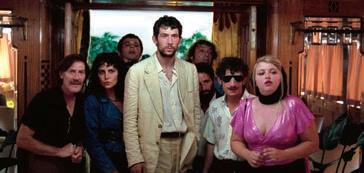
BURNING HEARTS – Strikingly shot is black and white this movie surrounds a forbidden relationship between a man and woman in rival families which rekindles a deadly feud. An intense crime story of love and revenge.
DELTA – Standout performances in this clash between local fishermen and poachers on the Po River in Northeastern Italy. A gritty and compelling drama starring Alessandro Borghi and Luigi Lo Cascio.
September 19 – October 18,
Screening at all Palace Cinemas
www.italianfilmfestival.com.au
The urgency and enormity of the Earth’s climate crisis is inversely proportional to the level of leadership being shown. This ludicrous fact is the impetus behind a new documentary film, Climate Changers, which follows preeminent Australian activist, Dr Tim Flannery on his quest to find genuine and effective champions of the cause somewhere on this planet.
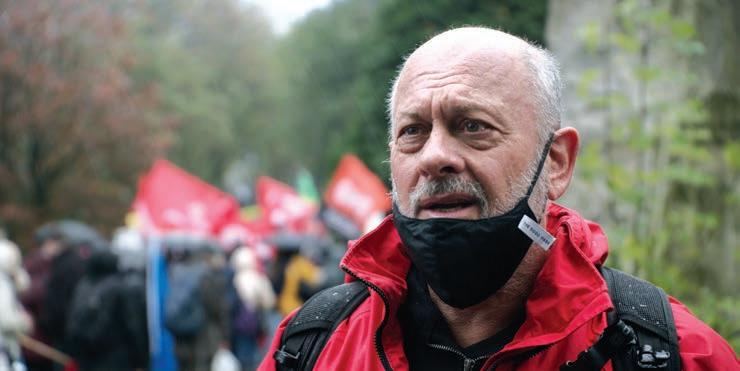
Written and produced by Mark Forstmann and directed by Johan Gabrielsson, Climate Changers features interviews between Flannery and a number of significant politicians, community leaders, activists and academics. Through a mix of on-location and archival footage, the film takes viewers to remote East Kwaio in the Solomon Islands where the threat is real and present; and to the echo chambers of COP summits in Copenhagen 2009 and Glasgow 2021.
The film premiered at this year’s Sydney Film Festival and was shortlisted for Best Australian Documentary Award and the Sustainable Future Award. It
screened with a Q&A afterwards that drew overwhelming participation.
It will screen again on September 17 along with a Q & A featuring Professor Tim Flannery, Dr. Saul Griffith and Kavita Naidu, and moderated by actor and activist, Yael Stone. Both film and Q&A will be live-streamed to theatres across the country and audiences anywhere can submit questions.
The film was made on a shoestring budget with some public funding
and lots of goodwill, says director Gabrielsson.
“And of course, it doesn’t hurt that you’ve got Tim Flannery as the main character in the film, because, you know, he’s very well known and respected and it’s, you know, a terrific guy,” he adds.
Gabrielsson is Swedish but has been living in Australia for quite some time. He believes the leadership in this country is lacking when it comes to
climate issues. (Not that he ranks Sweden much higher.)
“Sometimes I feel like we elect people and then we kind of leave them be and we let them sort it out — but they don’t.” He regards this film as a clarion call to everyone to wake up and put pressure on their leaders and also start taking some personal responsibility. At the same time, he wanted to avoid being too alarmist.
“I didn’t want to make a doom and gloom film because there are so many climate films that are really, you know, saying you got to do this, you got to do that or it’s all gonna go to shit quickly. You know, there’s still time and I just hope that the film is kind of optimistic in that sense.” September 17, 5:30pm with Q&A following.
NSW screenings: Ritz Cinemas Randwick, Dendy Newtown, The Regent Murwillumbah, Avoca Beach Picture Theatre, Village Cinemas Albury.
For more information about the film and other screening events visit: climatechangersmovie.com

